-
Plant Name & Description
Botantical Name
-
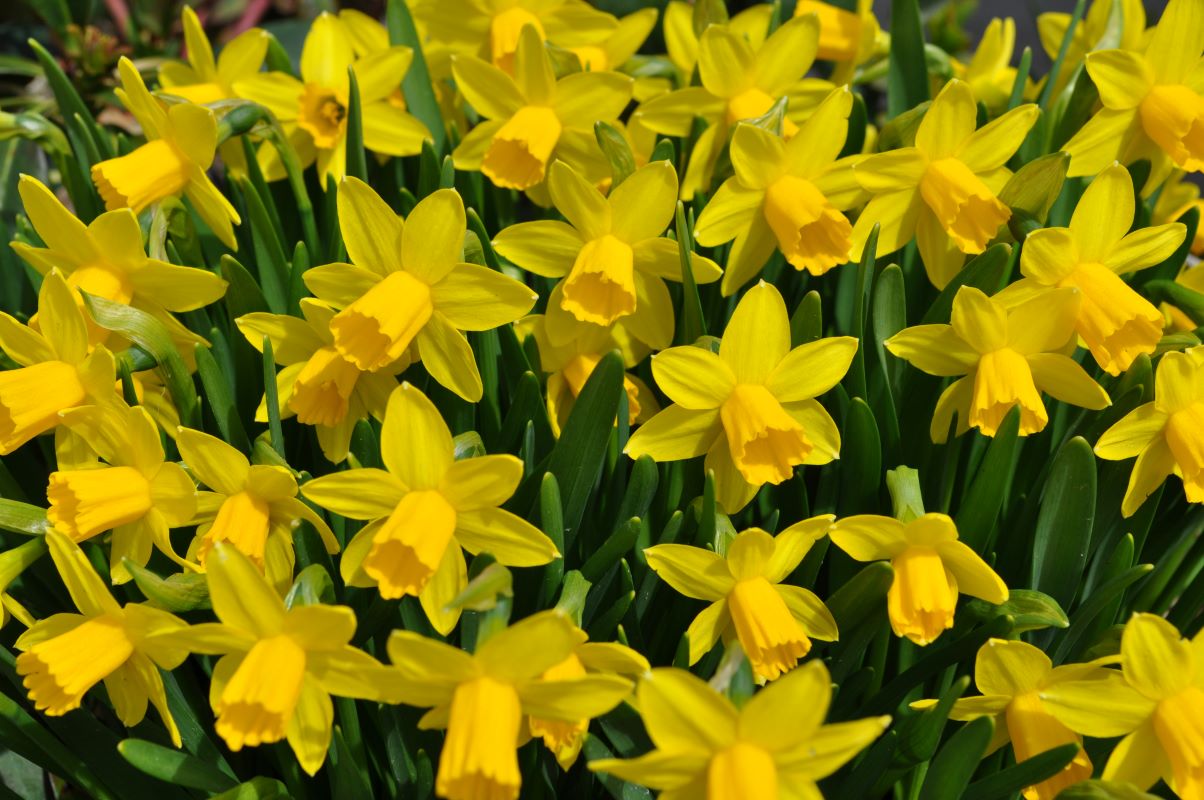
Daffodil Narcissus spp.
Group of varied bulbous perennials. Flowers are borne singly or in small clusters and consist of a trumpet surrounded by petals. Long slender leaves are dark green. Sizes vary from under 6 inches to close to 30 inches. Very deer resistant and tolerant of a range of soil types. A good example of a drought avoider, blooming early and reaching dormancy before the hot and dry months.
-
Dallas Blues Switch Grass Panicum virgatum 'Dallas Blues'
Clump-forming ornamental grass. Blue-green leaf blades are wider than most Panicums. Beautiful purple-tinged seed heads appear in late-summer to fall and provide great interest throughout the winter. Very versatile and tolerates a wide range of soil and climatic conditions. The species is native from Utah to the east coast.
-

Dalmatian Bellflower Campanula portenschlagiana
A low growing perennial that will add splashes of blue between steppingstones, along rock walls and climbing over rocks. The soft blue, bell-shaped flowers begin blooming in late spring and last through the summer. When it is out of bloom, rounded leaves with crinkled and irregularly toothed edges can be enjoyed.
-
Dalmatian Geranium Geranium dalmaticum
This tough perennial is native to the Balkan Mountains. Rounded, lobed leaves are covered by a flurry of pink flowers in the summer. Autumn brings orange and red hues to the leaves.
-
Dancing Butterflies Peony Paeonia lactiflora 'Dancing Butterflies'
Clump-forming herbaceous flowering perennial. Large fragrant deep pink single flowers are borne in late-spring. This early blooming variety is a showstopper. Dark green deeply lobed leaves are also very attractive. Plant in fertile well-drained soils. Tolerates some drought once established.
-
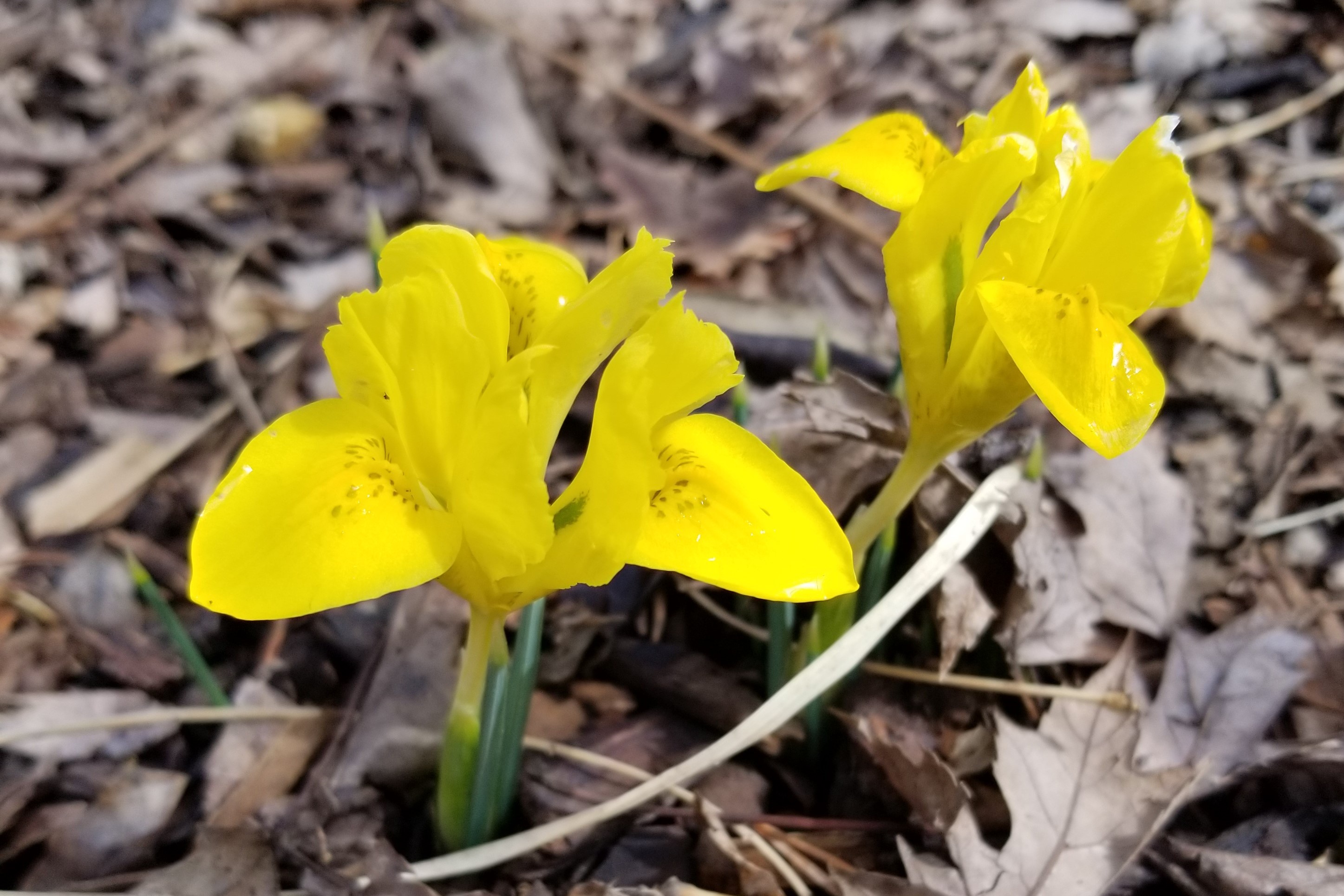
Danford Reticulated Iris Iris danfordiae
A bright yellow-flowered reticulated iris blooming in late winter to early spring. Its fragrant primrose-yellow flowers are 2" in diameter with tiny brown and black spots. It has grass-like leaves that disappear by late spring.
-
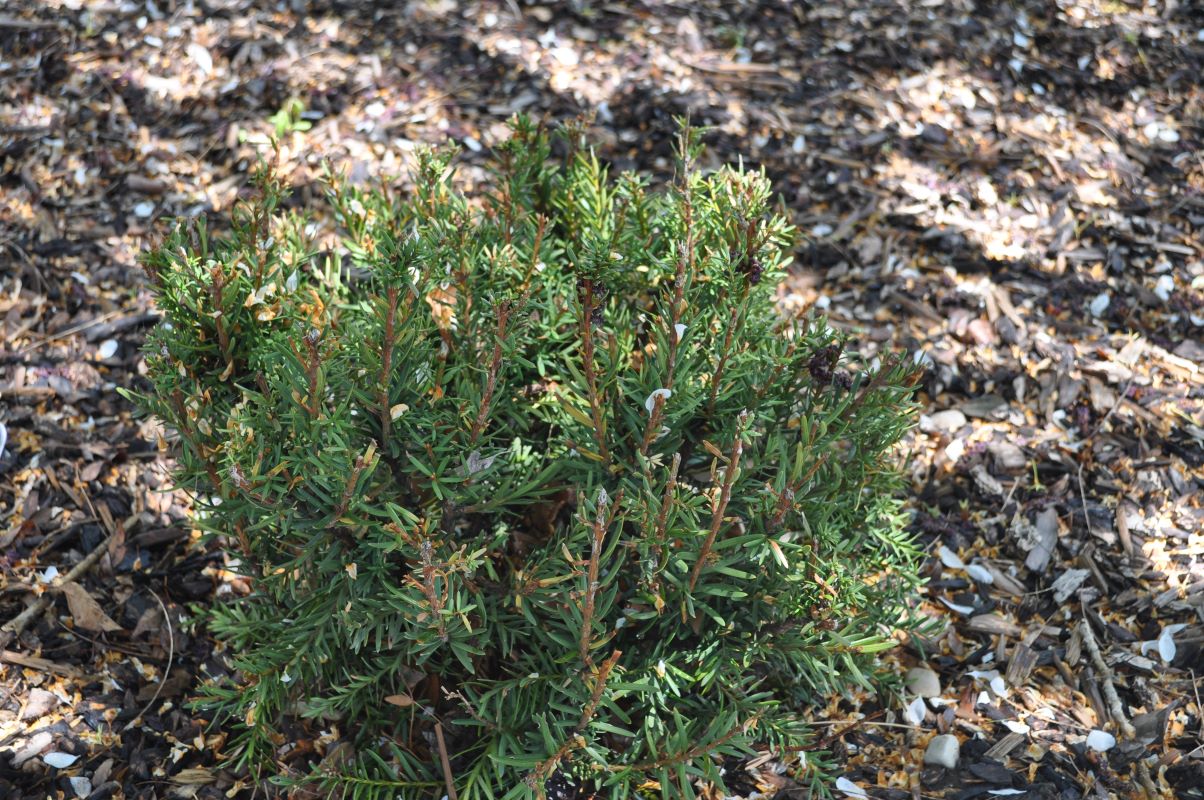
Dark Green Spreader Yew Taxus x media 'Dark Green Spreader'
Dense, spreading evergreen shrub. This shrub can be used for a hedge, border, or screen. Dark green needle-like foliage reaches out from the plant. Scarlet ornamental berries pop out from the branches. This cultivar has a low growing habit.
-

Dark Knight Bluebeard Caryopteris x clandonensis 'Dark Knight'
This is a nice 2-3 ft tall and wide perennial/shrub. It is best treated as a perennial along the Wasatch by being cut back each year. Prefers drier soils and full sun. Produces small blue flowers clustered together along each long stem. This variety grows darker blue flowers with green foliage. Fast growing.
-
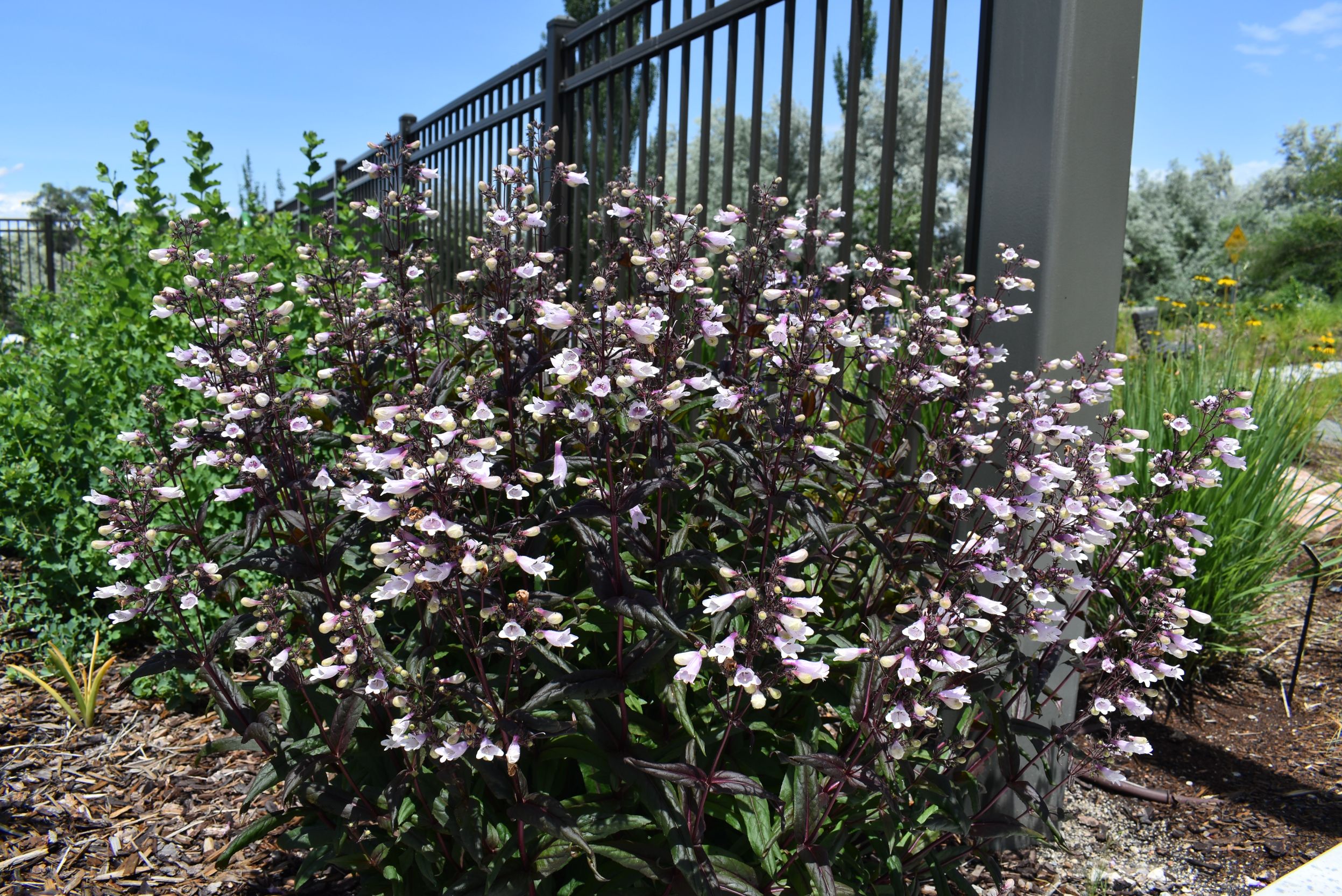
Dark Towers Penstemon Penstemon 'Dark Towers'
A striking upright perennial with dark wine-purple foliage and stems, which are topped with loose spikes of light lavender-pink, tubular flowers that bloom in late spring or early summer. The contrasting color, sharply textured leaves, and upright stems bring height and drama to perennial borders, with excellent heat tolerance and little maintenance. Grows best in well-drained soils.
-
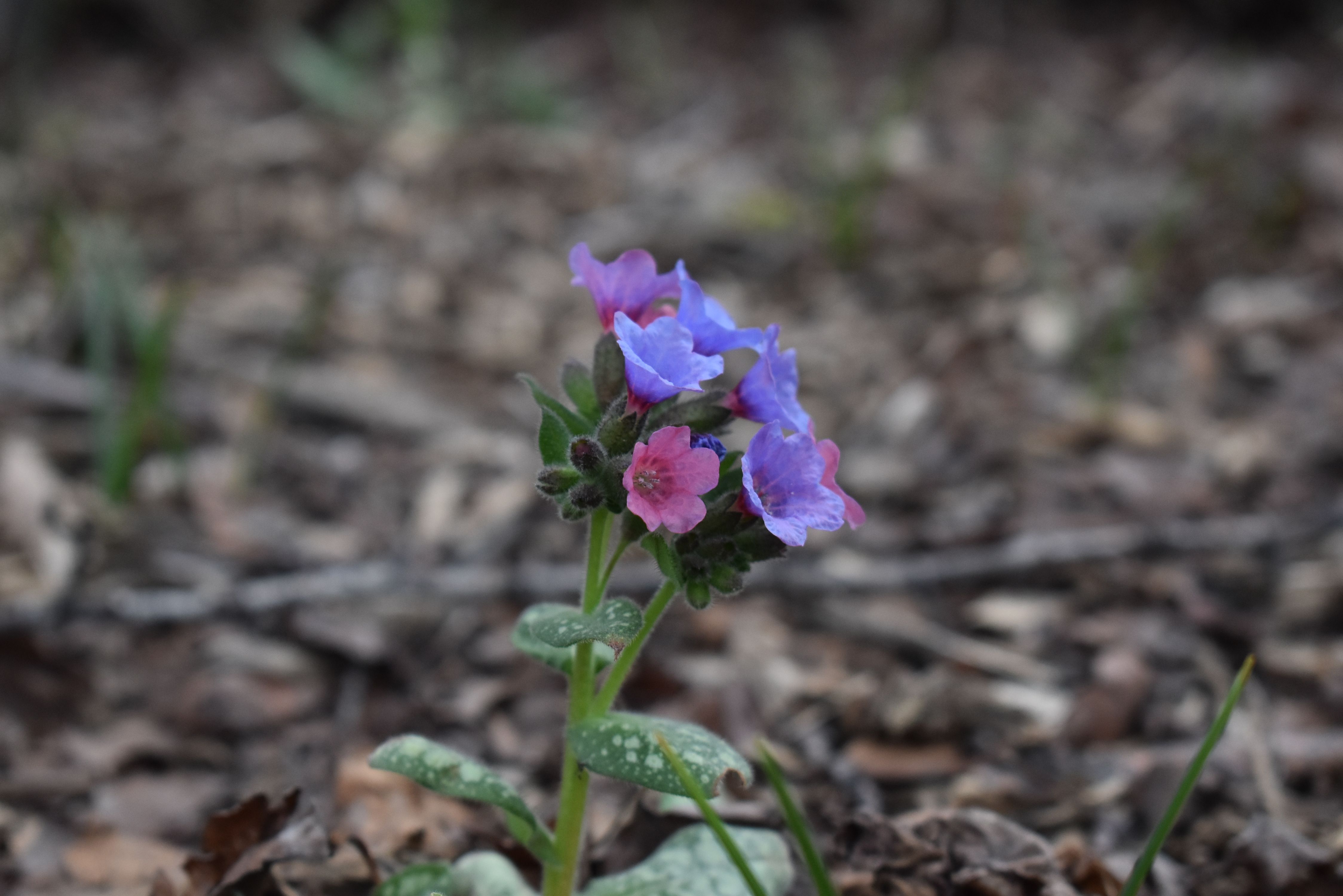
Dark Vader Lungwort Pulmonaria 'Dark Vader'
This early spring bloomer has clusters of small, bell-shaped pink, blue and purple flowers. The low-growing, semi-evergreen dark green foliage is spotted with pale silver-green, providing texture and interest all season long. Makes a good spreading groundcover for shady areas; avoid planting in areas with afternoon sun.
-

Dart's Gold Ninebark Physocarpus opulifolius 'Dart's Gold'
Compact, mounded deciduous shrub. Lobed leaves emerge golden yellow and mature to lime green in the middle of the summer. Clusters of white to pink flowers bloom in spring. Bark is exfoliating and reveals shades of red to brown underneath. Tolerates alkaline soils and drought.
-
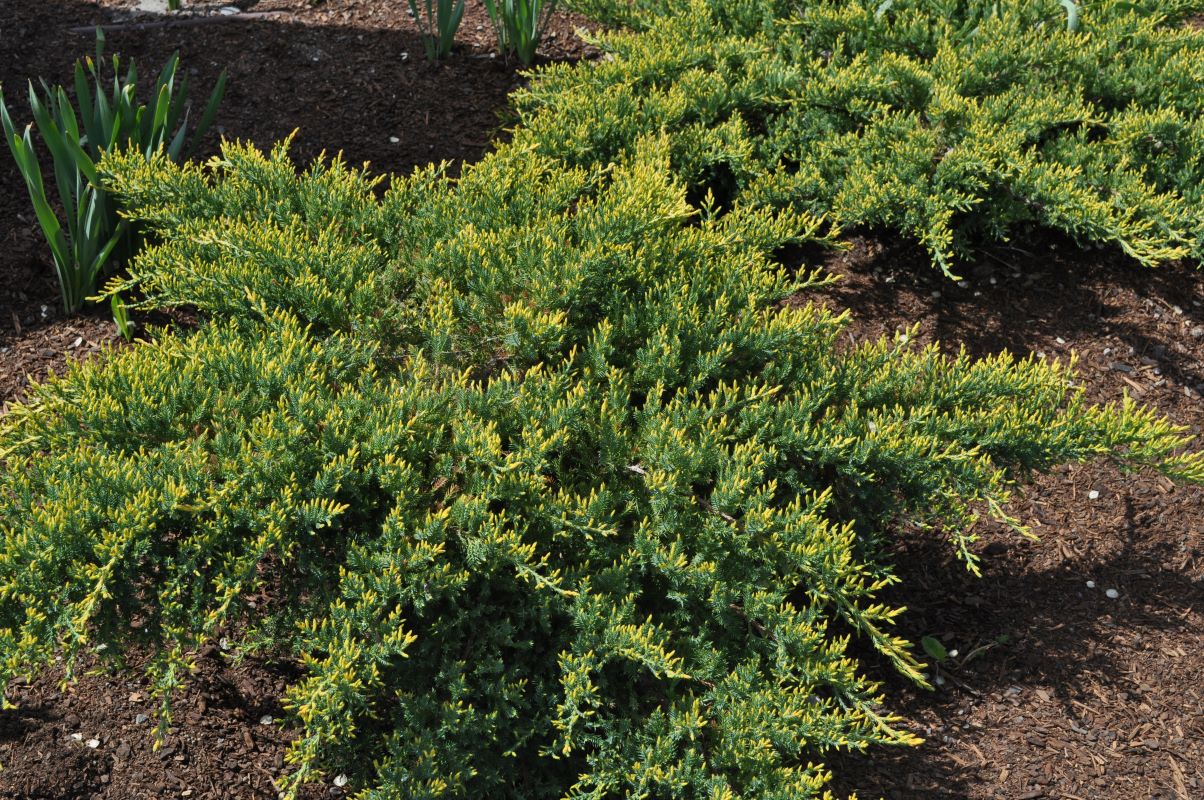
Daub's Frosted Juniper Juniperus chinensis 'Daub's Frosted'
Striking golden foliage tips give this low-growing evergreen shrub a frosted appearance against blue-green mature foliage. It works great as a groundcover and for mass plantings. It can survive without supplemental water once established, and does well in heat.
-
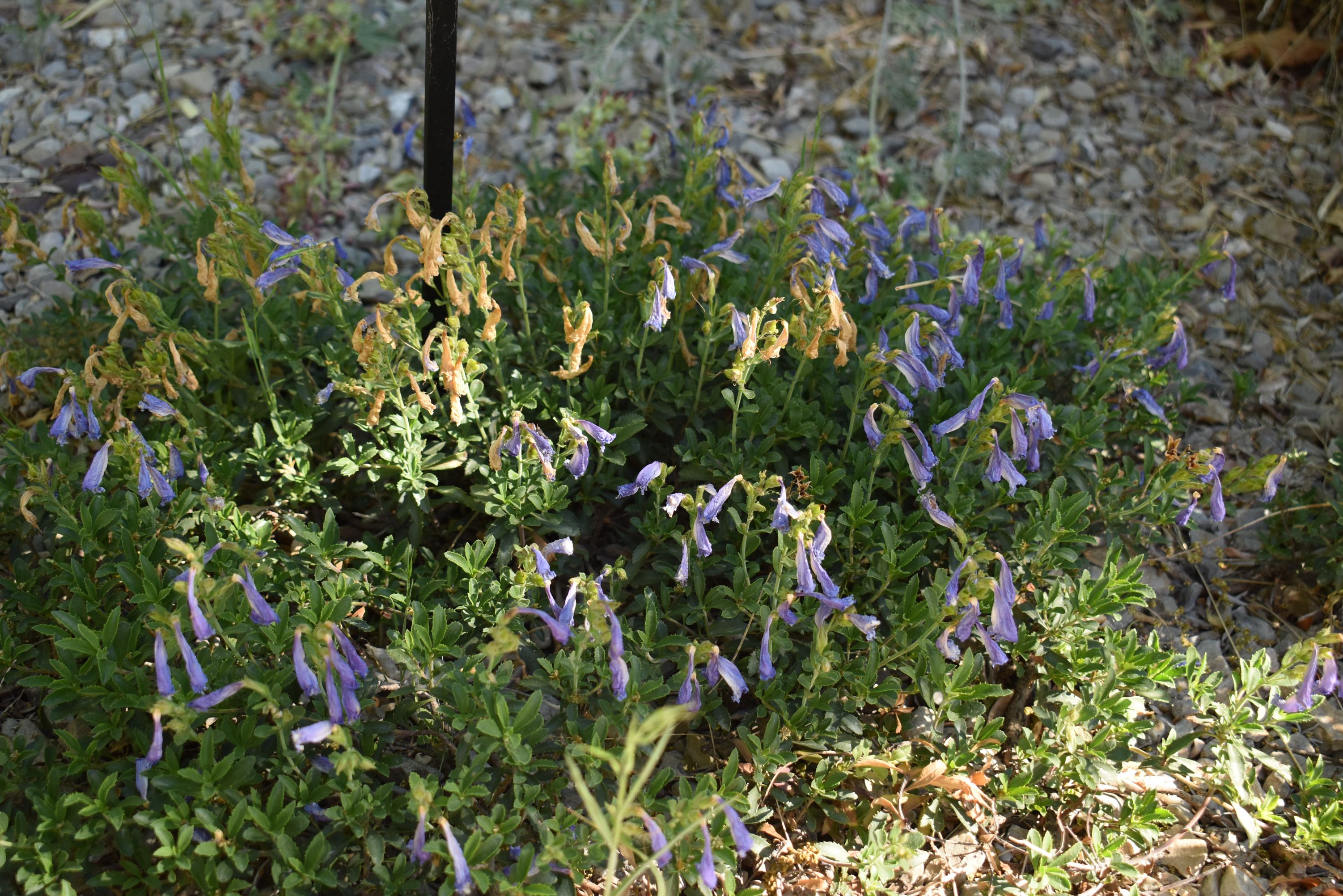
Davidson's Penstemon Penstemon davidsonii
A low-growing evergreen perennial that forms mats of leathery rounded dark green leaves. Bears clusters of dark pink or purple tubular flowers in late-spring to early-summer. Not as cold or heat tolerant as other penstemons but survives well in sheltered sites. Needs well-drained soils.
-
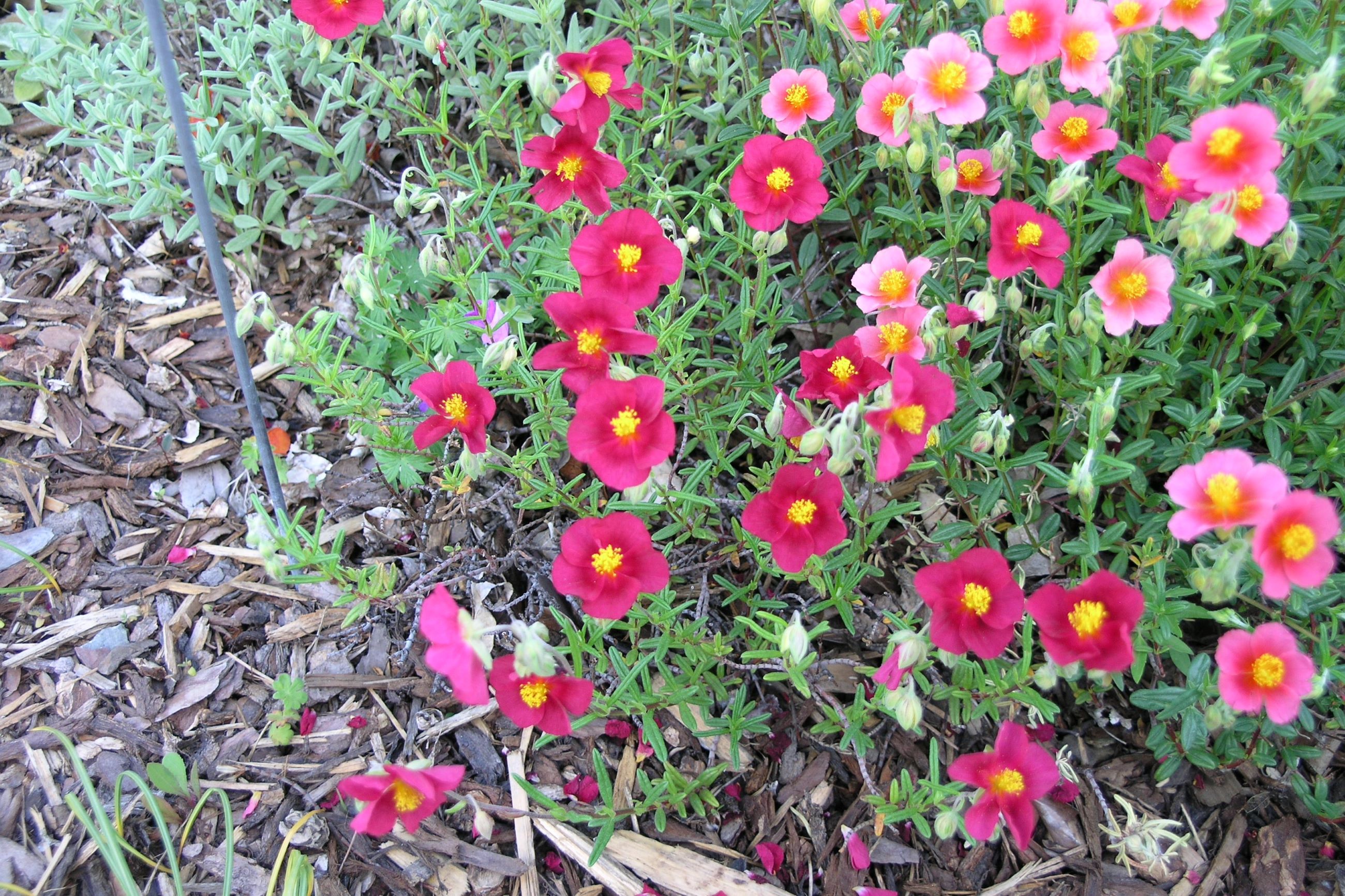
Dazzler Sun Rose Helianthemum 'Dazzler'
Low-growing, evergreen shrubby perennial. Small, silvery green, lance-shaped leaves are downy. Bears profuse deep red rose-shaped flowers in late-spring to early-summer. Grows well as a groundcover or in rock gardens. Presents a very stunning show when covered with flowers.
-

Deep Blue Arizona Sage Salvia arizonica 'Deep Blue'
A selection of Arizona sage, this perennial is one of the few that will provide color in shady areas. Clusters of deep blue flowers bloom on stalks over deer resistant foliage.
-
Denim 'n Lace Russian Sage Salvia yangii (syn Perovskia atriplicifolia) 'Denim 'n Lace'
Soft blue-purple flowers bloom atop gray green, subtly aromatic foliage. The blossoms are light and airy, creating an overall lacey effect. This perennial is great for adding color and fragrance to hot, dry areas in the landscape.
-

Desert Four O'Clock Mirabilis multiflora
This large Utah native plant spreads horizontally from a single large tap root. It has lush green leaves all season, with attractive magenta blooms appearing from mid-summer through frost. Requiring little or no additional water and not performing well if overwatered, this plant is a "must have" for any low-water landscape. Stems detach easily from the root at the end of the growing season for easy fall cleanup.
-

Desert Penstemon Penstemon pseudospectabilis
Semi evergreen perennial native to New Mexico. Bright pink to red tubular flowers bloom in summer. Large, gray-green leaves contrast nicely with the flowers. Prefers hot locations with dry, well-drained soils.
-
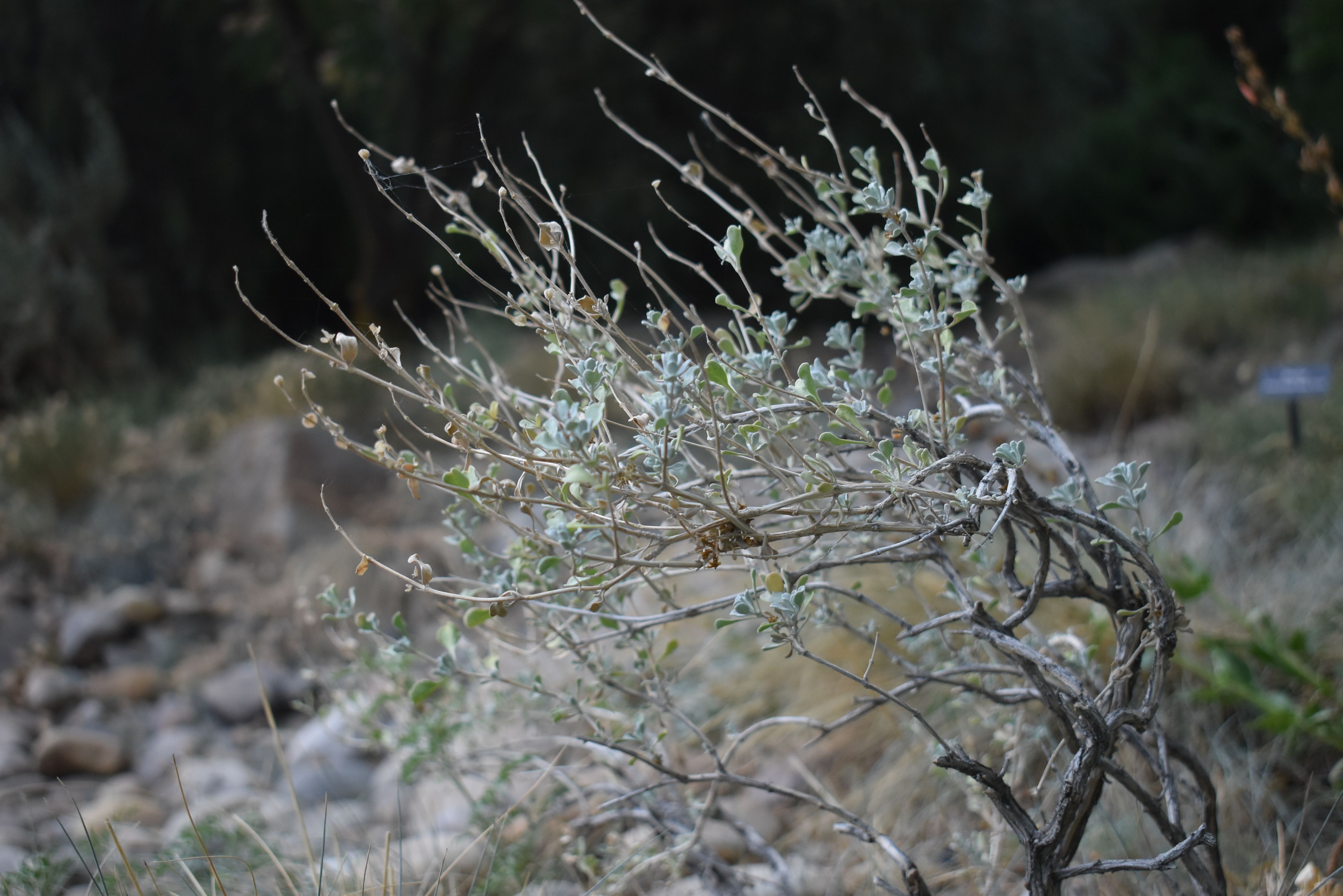
Desert Purple Sage Salvia dorrii
Fast-growing, heavy blooming, shrub. Native to the western United States. Highly aromatic gray leaves are resistant to browsing mammals. Brilliant pale-blue to purple flowers bloom in spring. Grows naturally in hot, dry, well-drained locations. Take care to not overwater in the landscape. Excellent plant choice for park strips.
-

Desert Sunrise Hummingbird Mint Agastache 'Desert Sunrise'
Upright growing fragrant perennial with a wispy look. Long-lasting bright orange-red blooms begin in mid-summer and last until the first freeze. This variety shows darker coloring than the species. Pale-green foliage emits a distinct root beer or licorice fragrance depending on your nose. Attractive to hummingbirds. Very drought tolerant but will use the water if it is available.
-

Desert Willow Chilopsis linearis
Small, multi-stemmed, deciduous tree with bright pink orchid-like flowers appearing throughout the summer. It is a favorite of hummingbirds. Despite its name it is not actually a willow, but rather a member of the legume family. Native to Utah but only semi-hardy in our zone and may have some branch die-back during the coldest years. Sometimes behaves more like a large shrub.
-
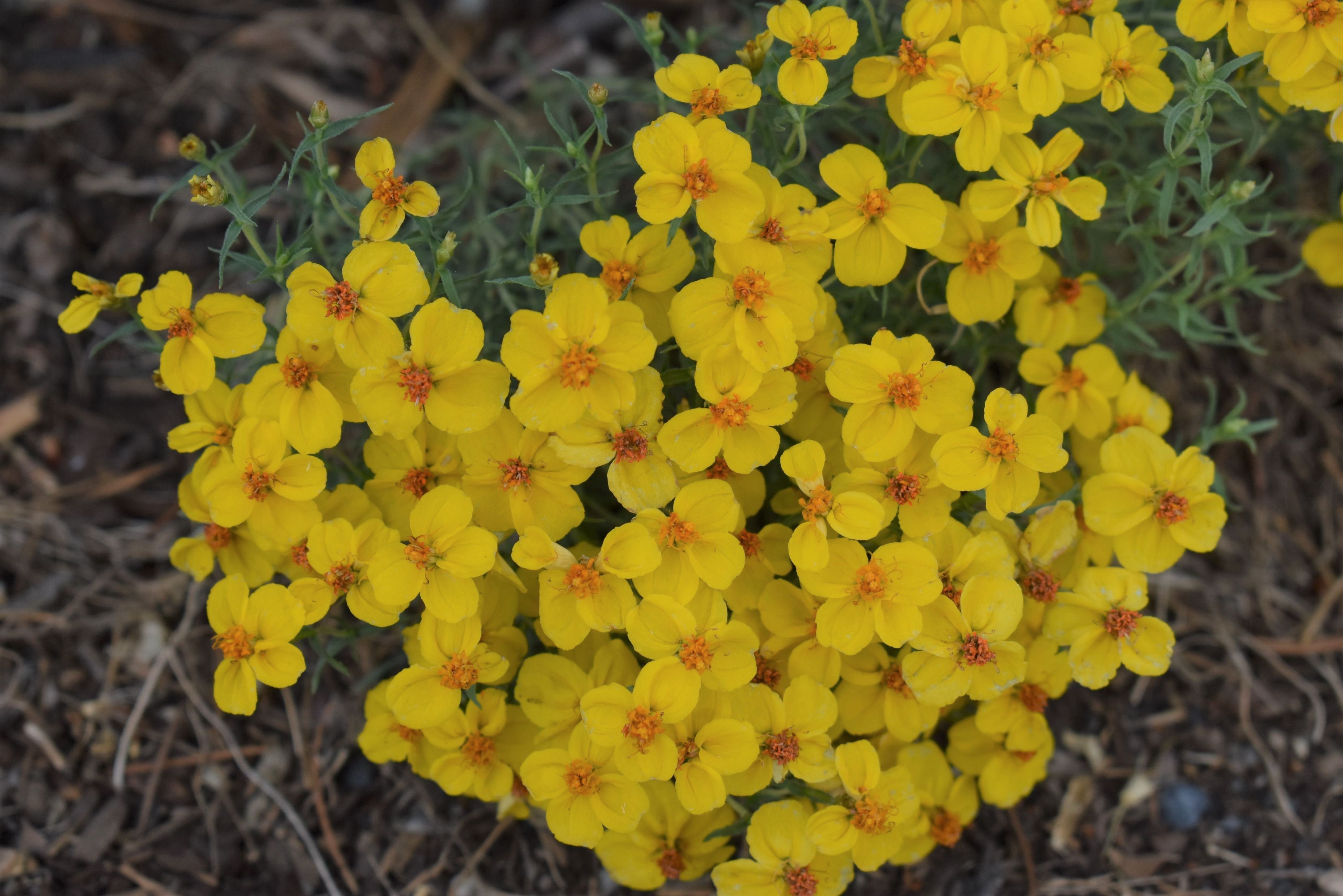
Desert Zinnia Zinnia grandiflora
Small, low-growing perennial native to the southwestern United States in some of the most inhospitable locations. Abundant, long-blooming golden-yellow flowers make this an attractive plant for any water-wise landscape. Comes out of dormancy in summer, so be patient. Prefers full sun and well-drained soil.
-

Diabolo Ninebark Physocarpus opulifolius 'Diabolo'
Upright, spreading, coarsely leaved shrub. The purple leaves of this cultivar provide a stunning backdrop for the bright whitish-pink flowers that appear in mid to late-spring. Bark exfoliates on older shrubs. In the heat of the summer, the leaves may green up slightly. Tolerates a wide range of soil conditions.
-
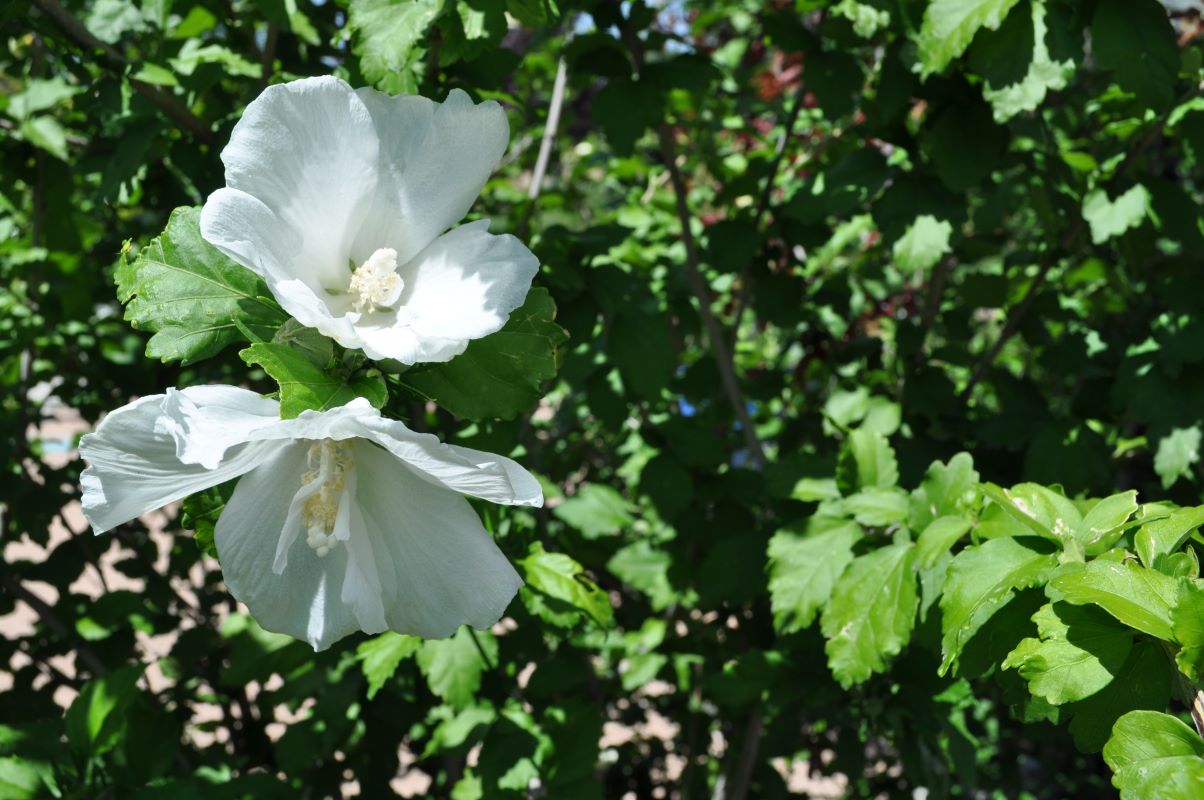
Diana Rose of Sharon Hibiscus syriacus 'Diana'
Vigorous, multi-stemmed, upright, deciduous flowering shrub. Numerous showy, pure-white, single-flowers, are borne throughout the summer. Attractive 3-lobed, coarsely toothed leaves grow on erect stems. Tolerant of heat, drought, and poor soils. Prefers fertile soils with moderate amounts of water.
-
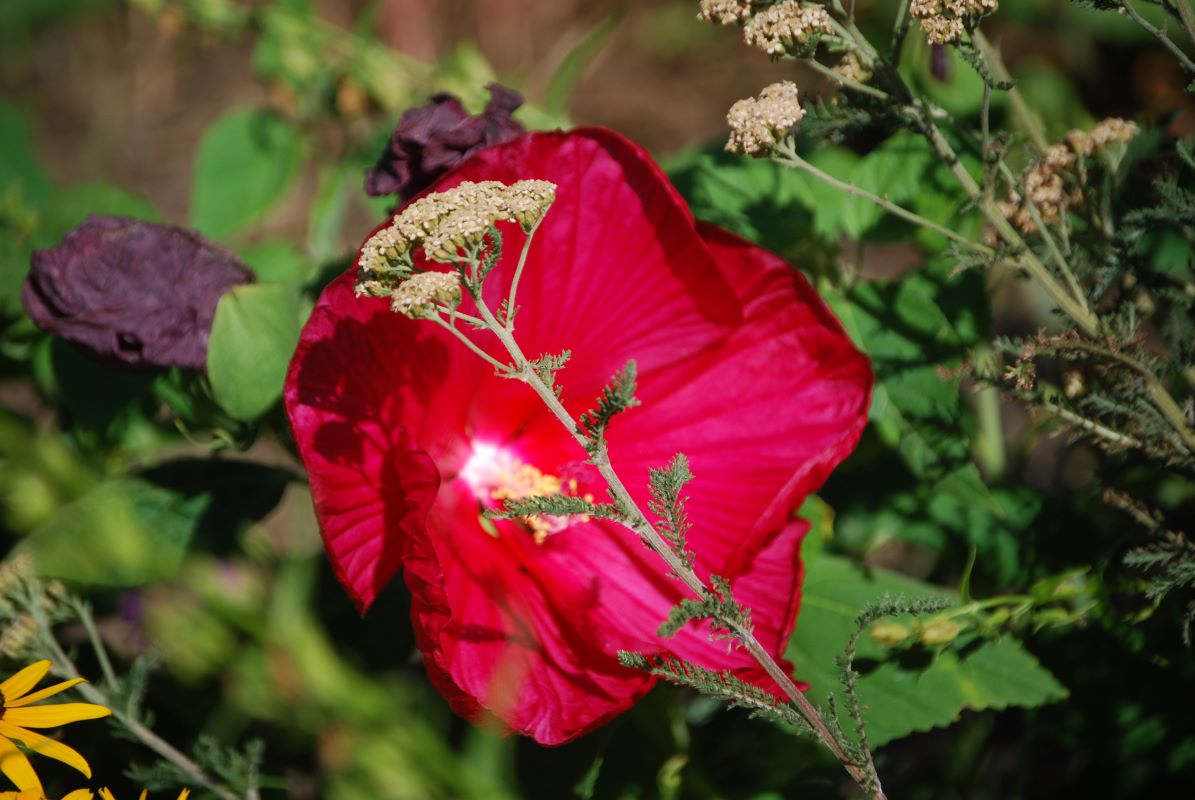
Disco Belle Rosy Red Hardy Hibiscus Hibiscus moscheutos 'Disco Belle Rosy Red'
A vigorous, compact, shrubby herbaceous perennial. Dinner plate-sized, five-petaled rose red flowers bloom throughout the summer. It is part of the Disco Belle series which has other cultivars that bloom pink and red, this one is considered red. Needs consistent water and prefers rich organic soils. Very showy, should be planted where the flowers are readily visible.
-
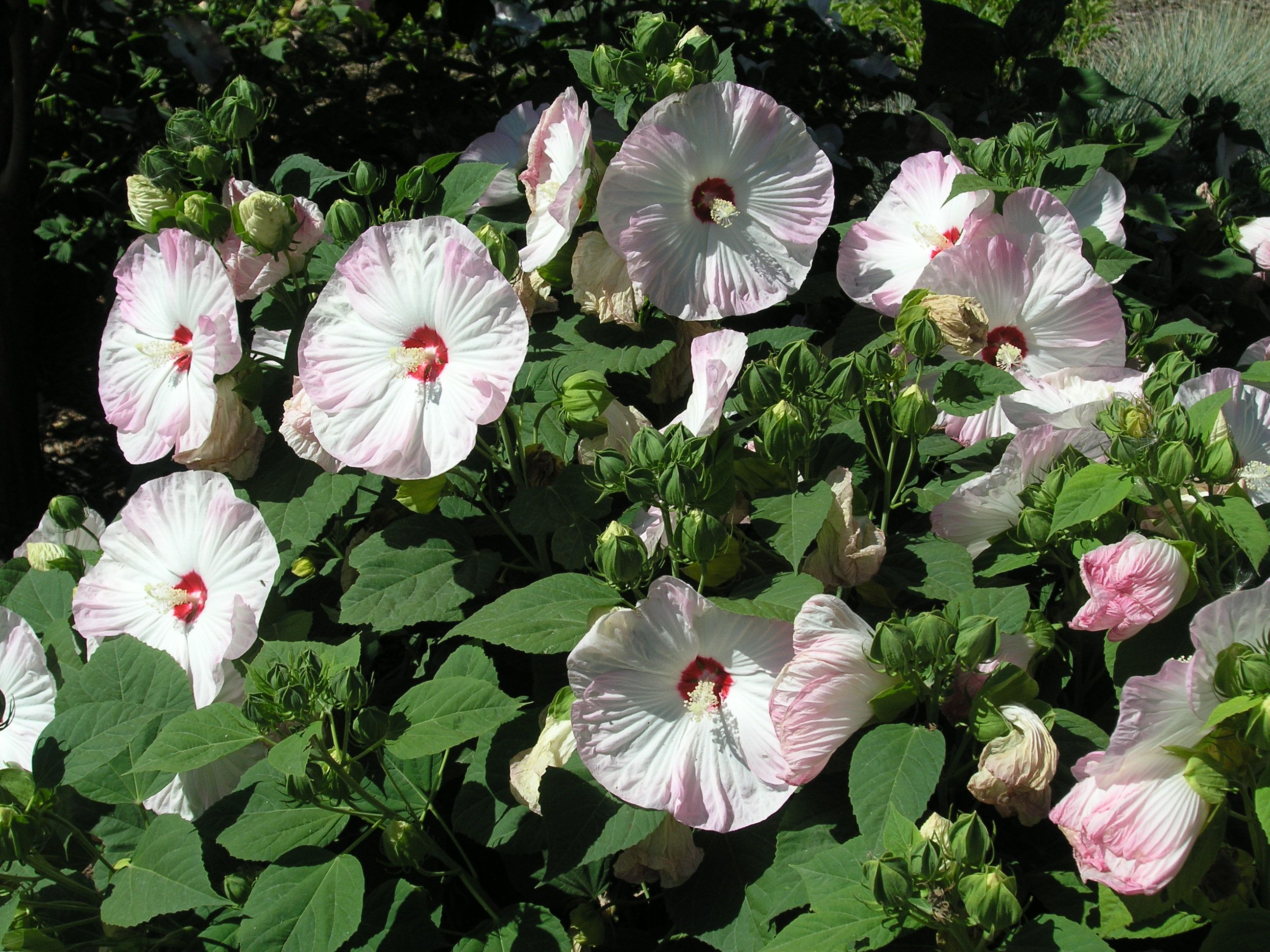
Disco Belle White Hardy Hibiscus Hibiscus moscheutos 'Disco Belle White'
A vigorous, compact, shrubby herbaceous perennial. Showy, dinner plate sized flowers are five-petaled and white tinged pink with maroon eyes. The flowers bloom in late spring and early summer. Part of the Disco Belle series which has other cultivars that bloom pink and red, this one is considered white. Needs consistent water and prefers rich organic soils. Very showy, should be planted where the flowers are readily visible.
-
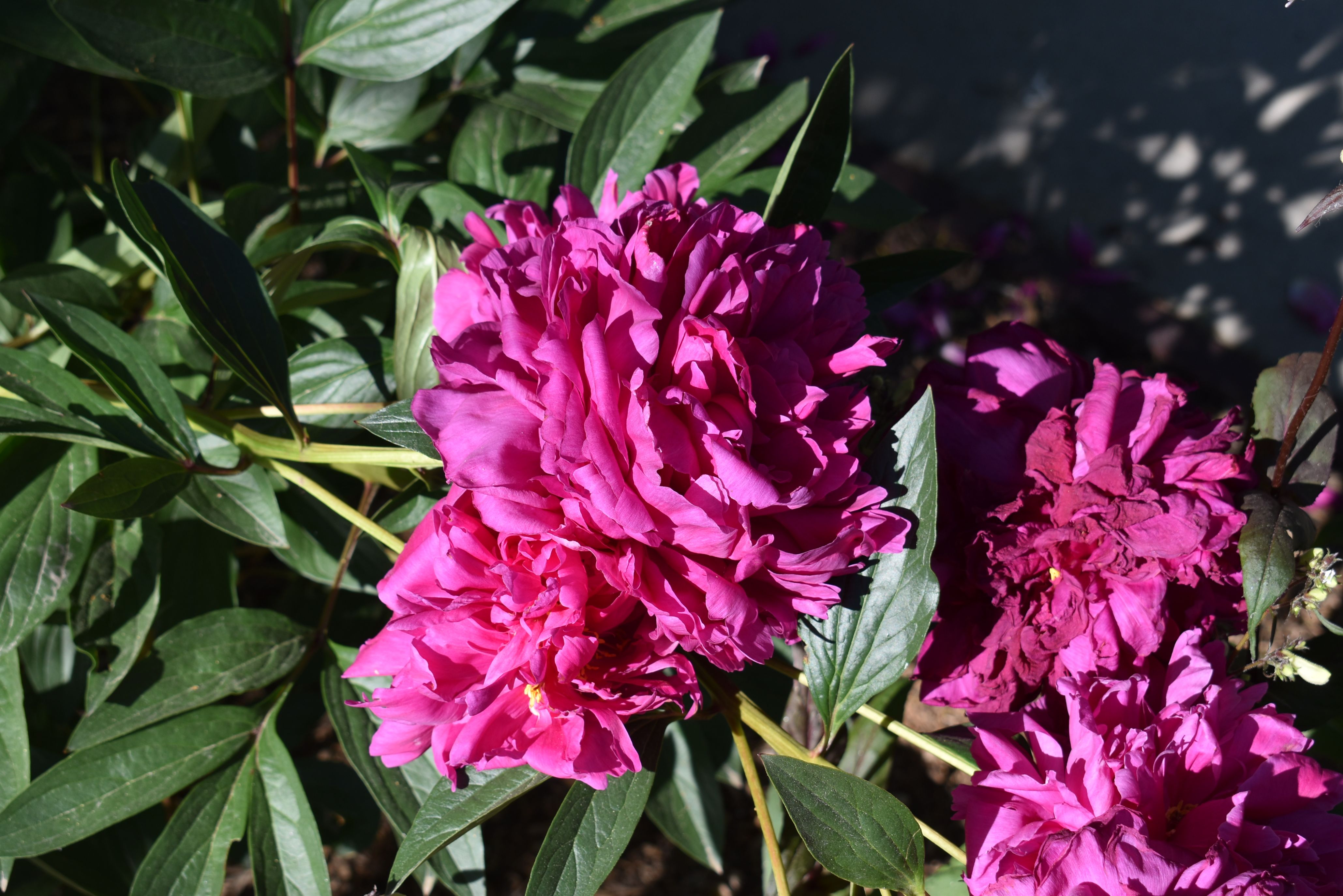
Doctor Alexander Fleming Peony Paeonia lactiflora 'Doctor Alexander Fleming'
A clump-forming, bushy herbaceous perennial. Large pink fragrant blossoms are fully double. Outer petals are broad and spreading with curving inner petals. Deeply-lobed green foliage looks great even when not in bloom. Excellent as a cut flower. Plant in fertile soil. Do not overwater. Tolerates some drought once established.
-
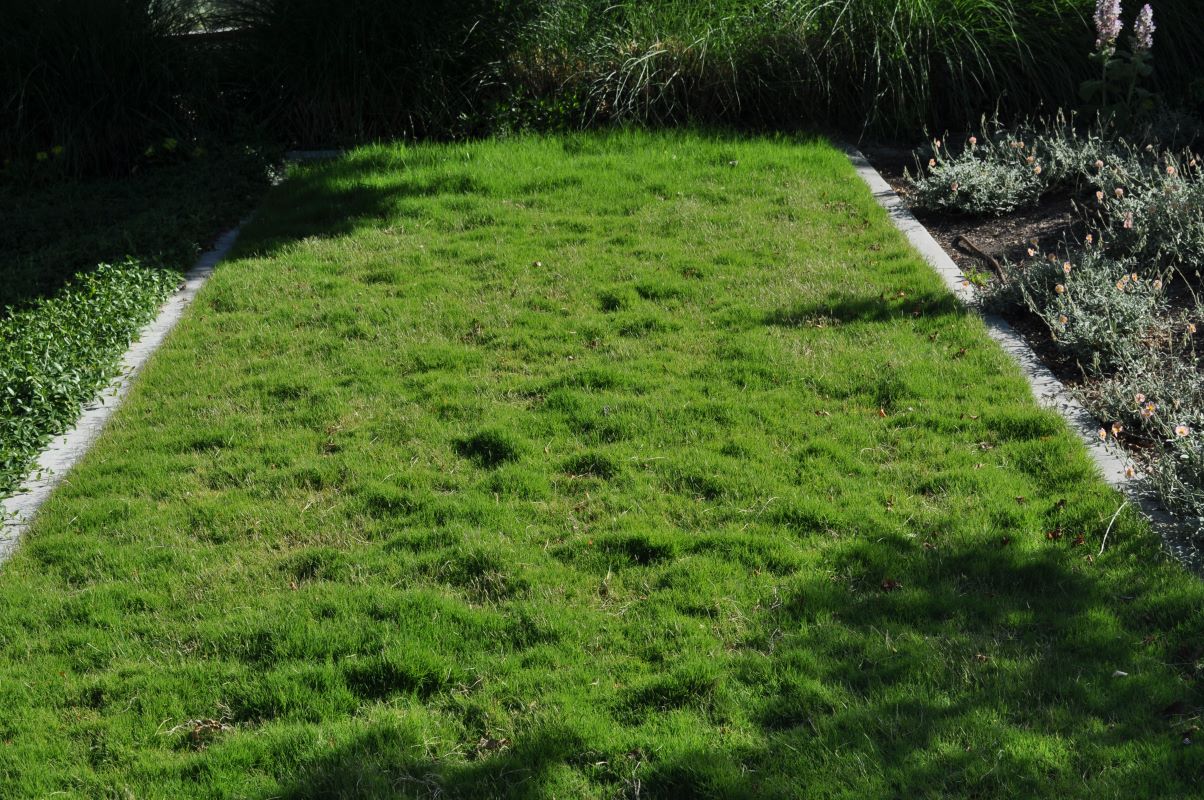
Dog Tuff Grass Cynodon hybrida Dog Tuff
Dog Tuff is a deep-rooted, dense, low-growing turf grass. It is very drought resistant and provides a tough, durable lawn. Ideal for play, this grass stands up to dog traffic and dog urine with little or no damage. As a warm season grass, greening up won't happen until June and dormancy occurs in early October. Dog Tuff does not require mowing, but instead will gently mound. No seed is produced, but it does grow aggressively by underground rhizomes.
-
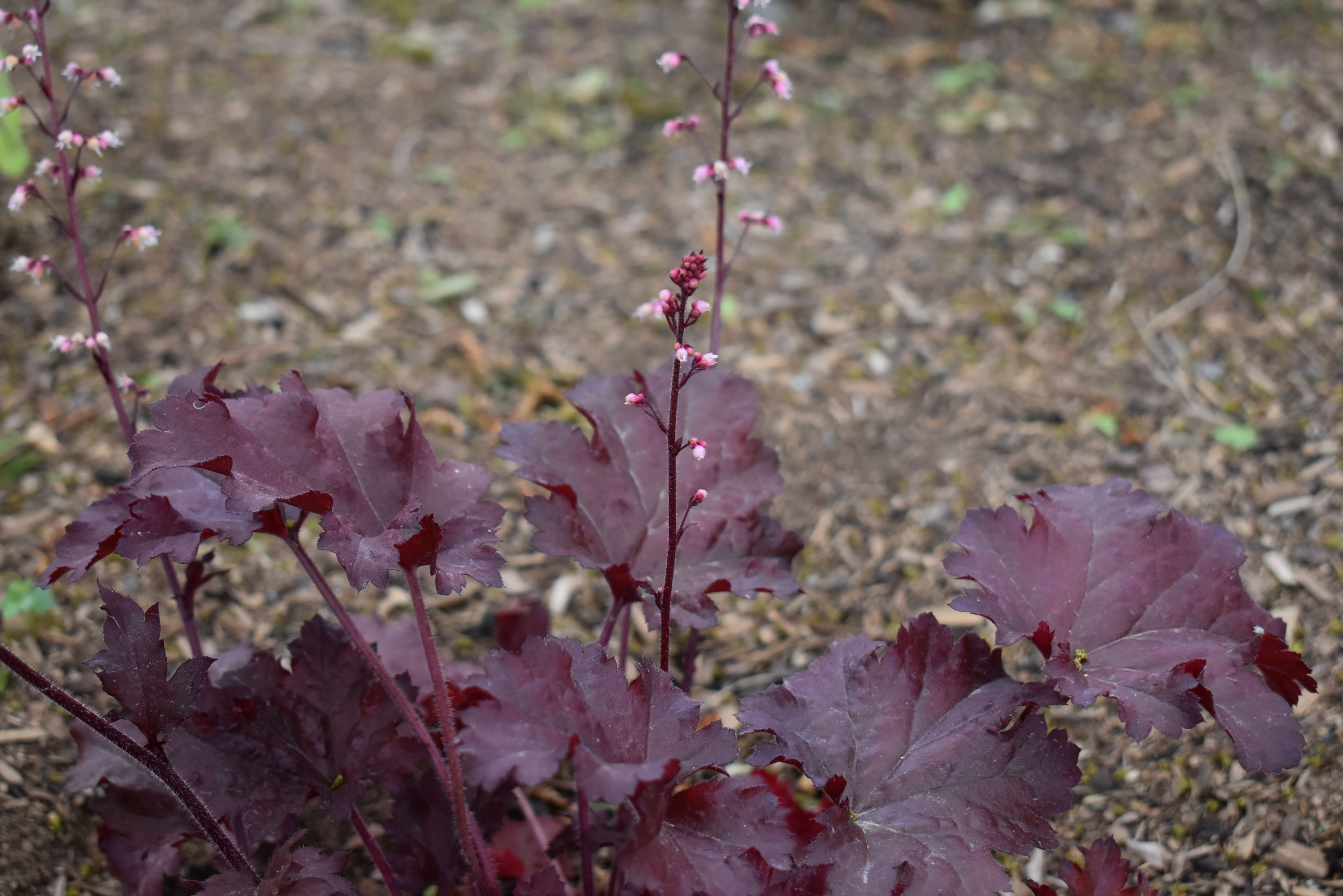
Dolce Cherry Truffles Coral Bells Heuchera 'Cherry Truffles'
This low, mounding coral bells features ruffled, vivid red foliage. The leaves mature to a more rich, deep red. Summertime brings dainty, light pink flowers that pair beautifully with the bold foliage below. 'Cherry Truffles’ thrives in full sun to full shade, making it a great choice for any place in the landscape.
-
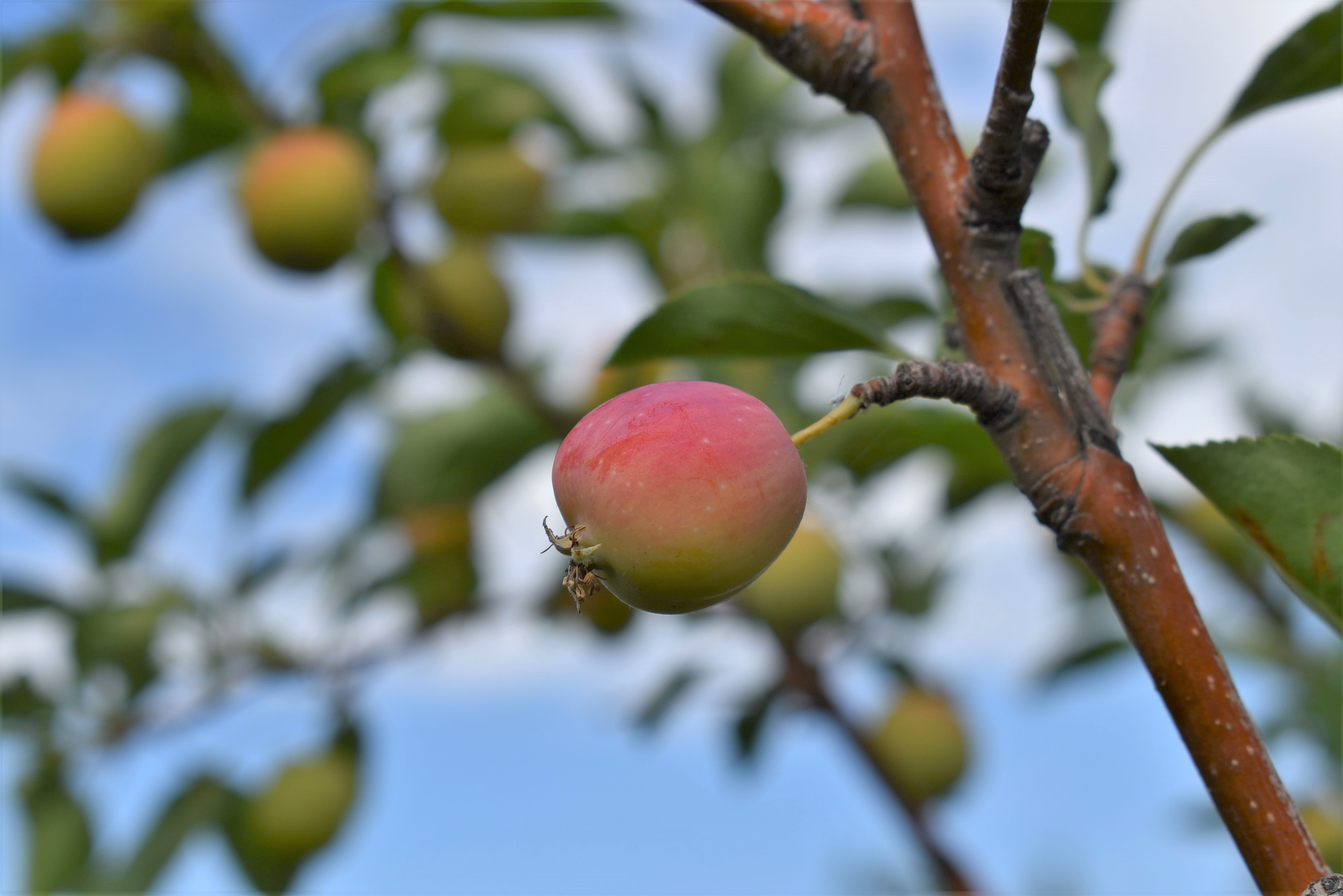
Dolgo Crabapple Malus 'Dolgo'
This large, rounded crabapple tree is known for its heavy crop of uniquely large, flavorful fruit which ripen in August and persist on the tree into December. The high-pectin fruit are prized for jelly making. In the spring it holds its own with plenty of long-blooming white flowers. Coppery-orange bark gives it visual interest year-round. Cold-tolerant, disease-resistant and great for pollinators and wildlife.
-

Dorset Sentry Red-Hot Poker Kniphofia 'Dorset Sentry'
This perennial has fleshy grass-like leaves that grow in a clump. Tubular, acid yellow flowers grow in clusters on top of long stems. The leaves are mid-green and not too showy, but are easy to maintain when not flowering. Red hot pokers are robust plants that require some water but will handle drought.
-
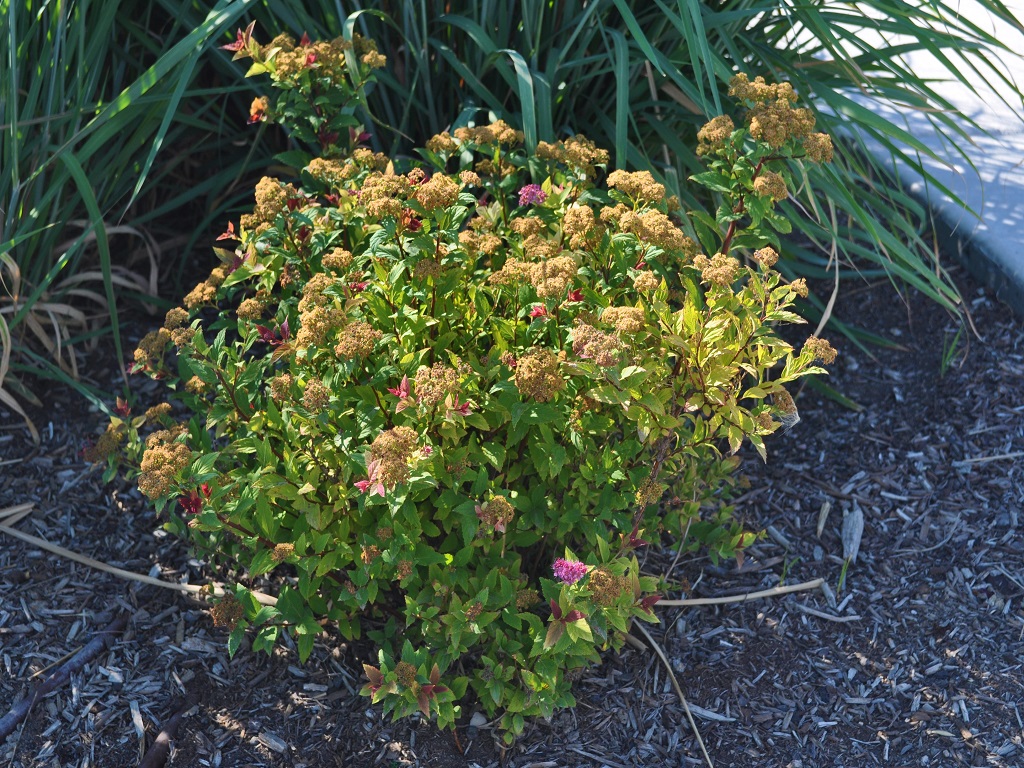
Double Play Artisan Spirea Spiraea japonica 'Galen'
Compact, mounded plant known for its bright color of foliage and flower. New growth of leaves remain red and compliment with rich pink flower in summer. Easy to grow and has more vivid color than other species of Spirea.
-
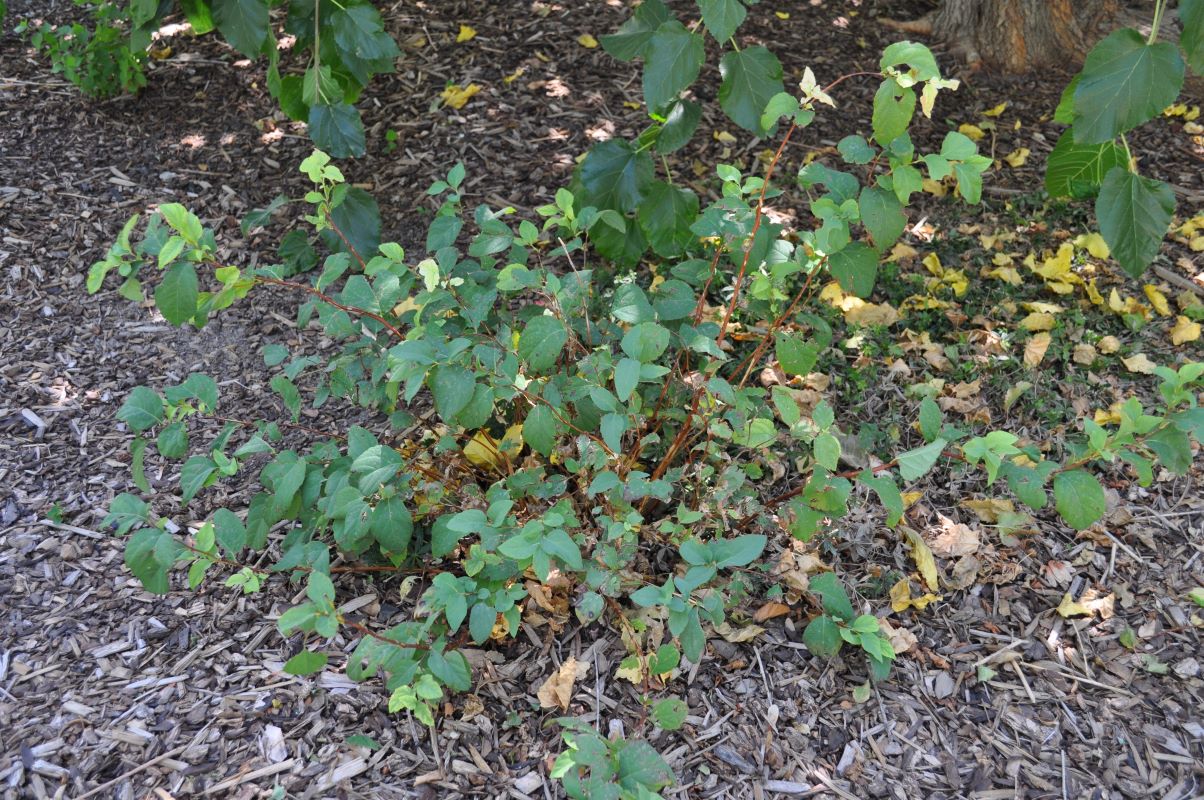
Double Play Blue Kazoo Spirea Spirea media 'SMSMBK'
Part of the Double Play series, Blue Kazoo is noteworthy for its blue-green spring foliage that turns red in the fall. Clusters of white flowers bloom in late spring to early summer. The shrub is medium height and works best in full sun.
-
Double Play Gold Spirea Spiraea japonica 'Yan'
Compact, mounded deciduous shrub. Elliptical leaves emerge golden yellow turning to light green in the summer. Flat-topped clusters of dark-pink flowers bloom in late-spring to early summer. Grows best with moderate amounts of water and in full sun.
-
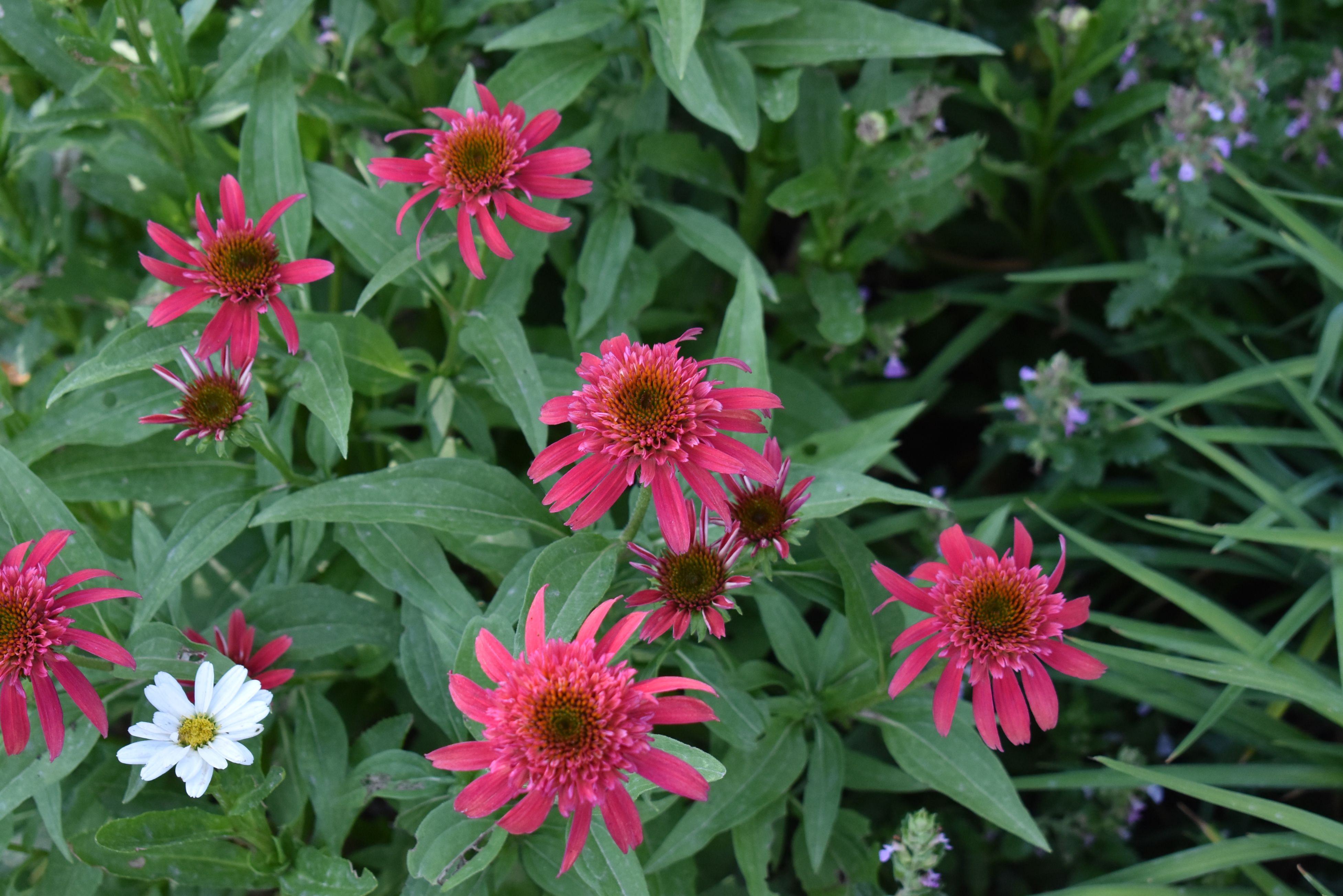
Double Scoop Cranberry Coneflower Echinacea x purpurea 'Balscanery'
The large cranberry-colored blossoms will bloom for months. Blooms will produce best when wilted flowers are removed. This coneflower is perfect for sunny borders or mixed containers.
-
Double Take Peach Quince Chaenomeles speciosa 'NCCS4'
This Flowering Quince outdoes many of the older varieties with its thornless nature and large, romantic peachy colored double blossoms. The flowers come on in spring and will add color and texture to the landscape for a long period of time. On top of this longer bloom period, the blooms often return in the fall and bring warm, spring color to the cooler part of the year.
-
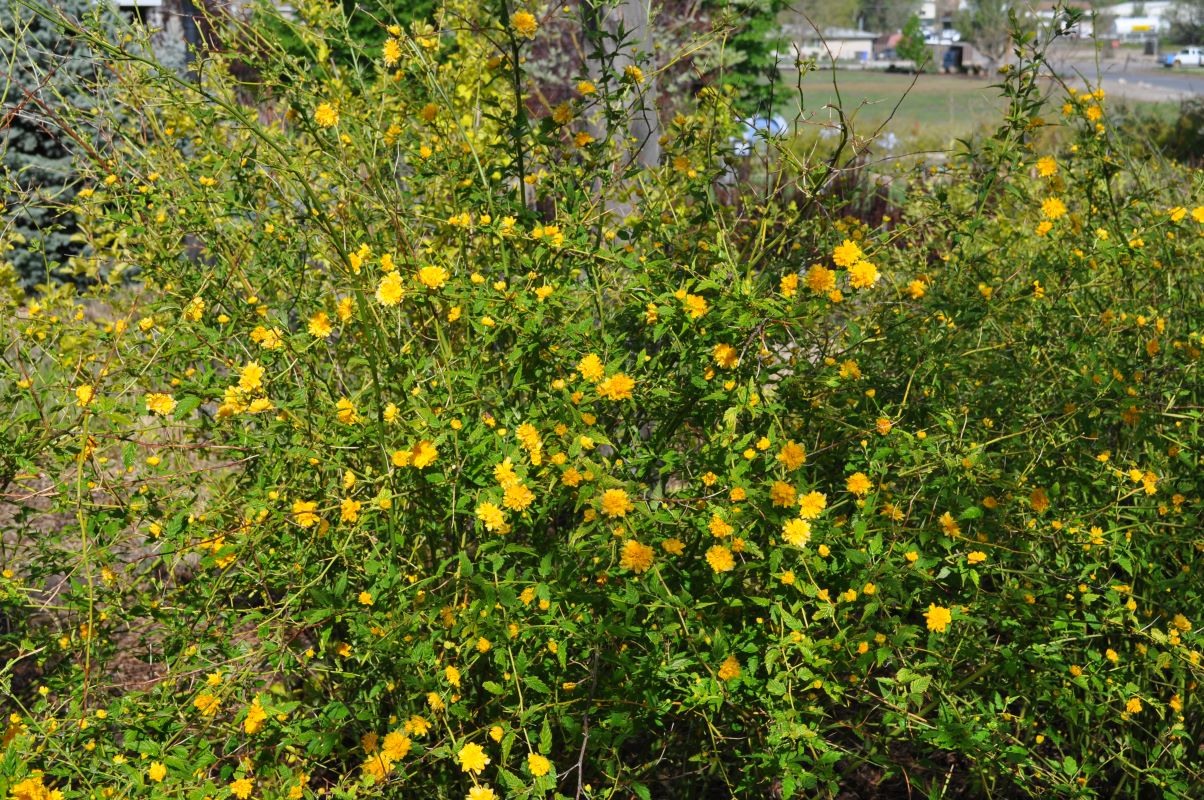
Double-Flowering Japanese Kerria Kerria japonica 'Pleniflora'
Graceful deciduous shrub with more upright growth than the species. Flowers appear in early-spring, many times around Easter, so it is sometimes called an Easter Rose. Bright-yellow flowers are double on this variety. Arching stems are slender and have a nice green color that remains throughout the fall. Flowers look the best in part-shade and will fade in full-sun.
-
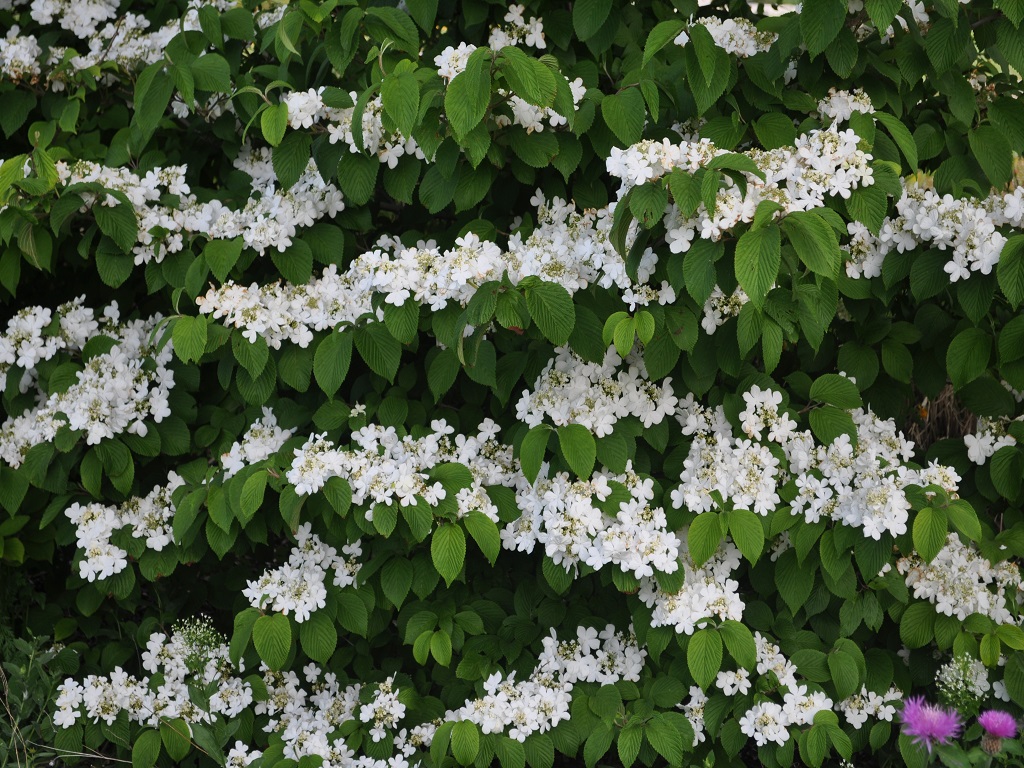
Doublefile Viburnum Viburnum plicatum f. tomentosum 'Shasta'
A wide-spreading deciduous shrub with tiered horizontal branches that are thickly topped with flat, lacy clusters of white flowers in spring, and showy red berries in fall. Foliage is dark green and deeply veined, giving it a pleated appearance. A stately and graceful shrub for mixed borders.
-
Doyenne du Comice Pear Pyrus communis 'Doyenné du Comice'
Deciduous, fruit-bearing tree. Pure white flowers bloom in mid-spring followed by medium to large pears that ripen in October. Ripens to a greenish-yellow with a slight blush. Requires moderate amounts of water to support fruit growth. Like most fruit trees, it is available in different sizes depending on the grafted root system. Will require some pest control.
-

Dragon's Blood Stonecrop Sedum spurium 'Schorbuser Blut'
Vigorous, mat-forming, evergreen perennial with dark purple-tinted leaves. Late summer brings rounded corymbs of dark-pink flowers. Plant in well-drained soils. Prefers moderate amounts of water but may tolerate some drought. Flowers best in full sun.
-

Dream Catcher Beautybush Kolkwitzia amabilis 'Maradco'
The leaves of this large shrub emerge with orange tones but quickly turn to yellow and then chartreuse as the season progresses with a finale of autumn gold and orange. It blooms in spring with pink, bell-shaped flowers. Mature bark exfoliates with maturity, which can be very attractive in winter. The stems can become dense and overgrown, so it needs plenty of pruning. Generally thinning will be enough, but an occasional cutting back will do some good. Flowers bloom on old wood, so cutting back the stems will result in no flowering for that season.
-

Dropmore Scarlet Honeysuckle Lonicera x brownii 'Dropmore Scarlet'
Vigorously-growing semi-evergreen climbing vine. Leaves are rounded and often grow around the stem. Tubular red flowers are not very fragrant but attractive to hummingbirds. Twine stems around supports to help the plant grow upwards. Can handle severe pruning if overly vigorous.
-
Druett's Variegated Campion Silene uniflora 'Druett's Variegated'
This perennial covers the ground with tiny, lance-shaped green variegated leaves. Small ballooned flowers bloom white in the summer. Great for rock gardens, rock walls and anywhere it can cascade or trail. It prefers good drainage and plenty of nutrients and moisture. However, it can handle some drought once established. Remove any solid-green shoots to maintain variegation, as this plant has a tendency to revert.
-
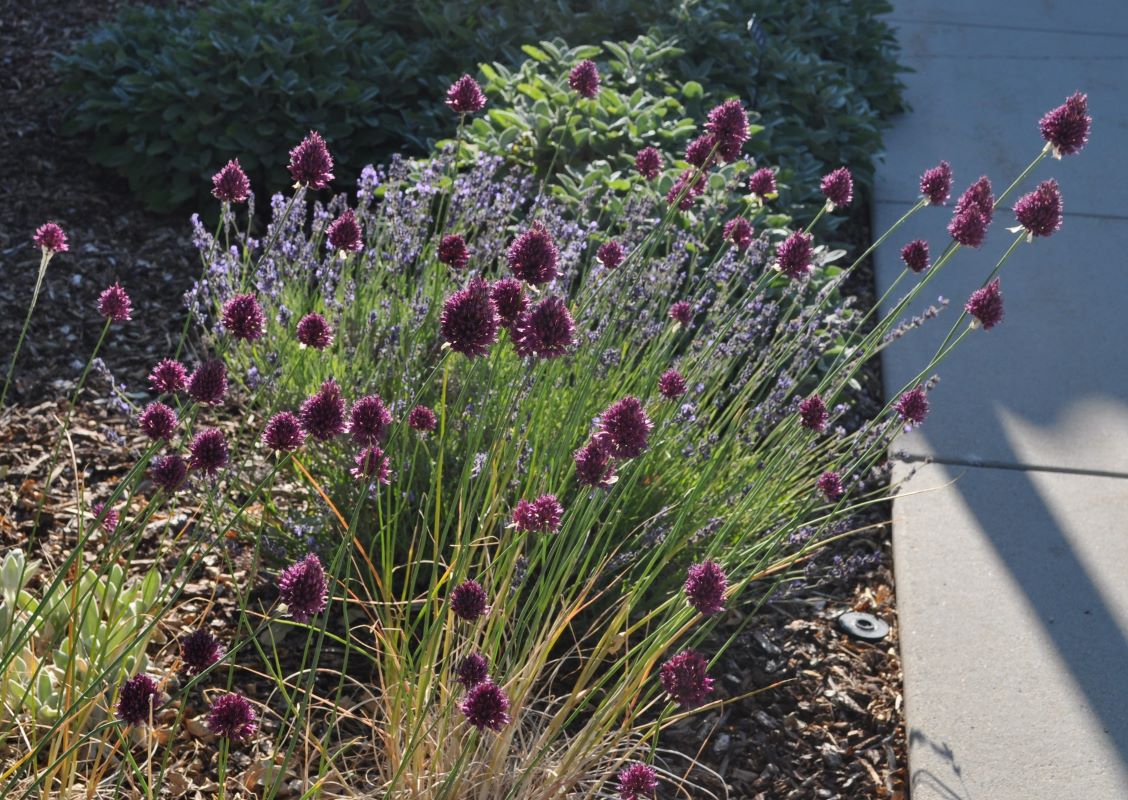
Drumstick Onion Allium sphaerocephalon
Ornamental bulbous perennial onion. Long linear basal leaves form untidy clumps. Forms tightly packed umbels of up to 40 pink to purple bell-shaped flowers in the summer. Plant in clumps 3 inches apart. Low water use and low maintenance. Good choice for full sun borders.
-
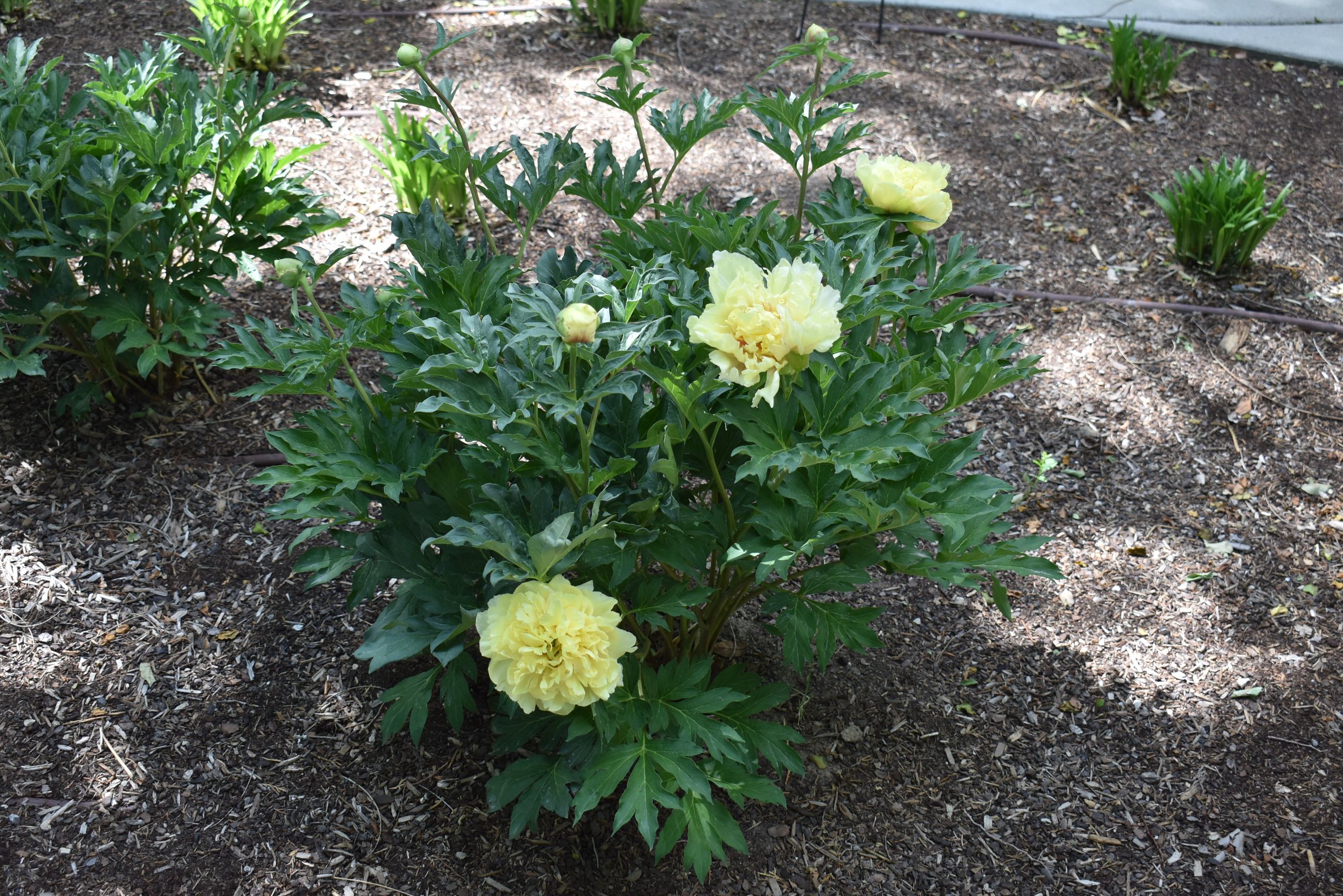
Duchesse de Lorraine Itoh Peony Paeonia 'Duchesse de Lorraine'
This bushy perennial offers large, fluffy, creamy yellow blossoms in late spring to early summer. These flowers stand out against the dark green, lance-shaped leaflets. The Duchesse is perfect for adding bursts of color and fragrance throughout the landscape. The sturdy stalks make staking unnecessary.
-
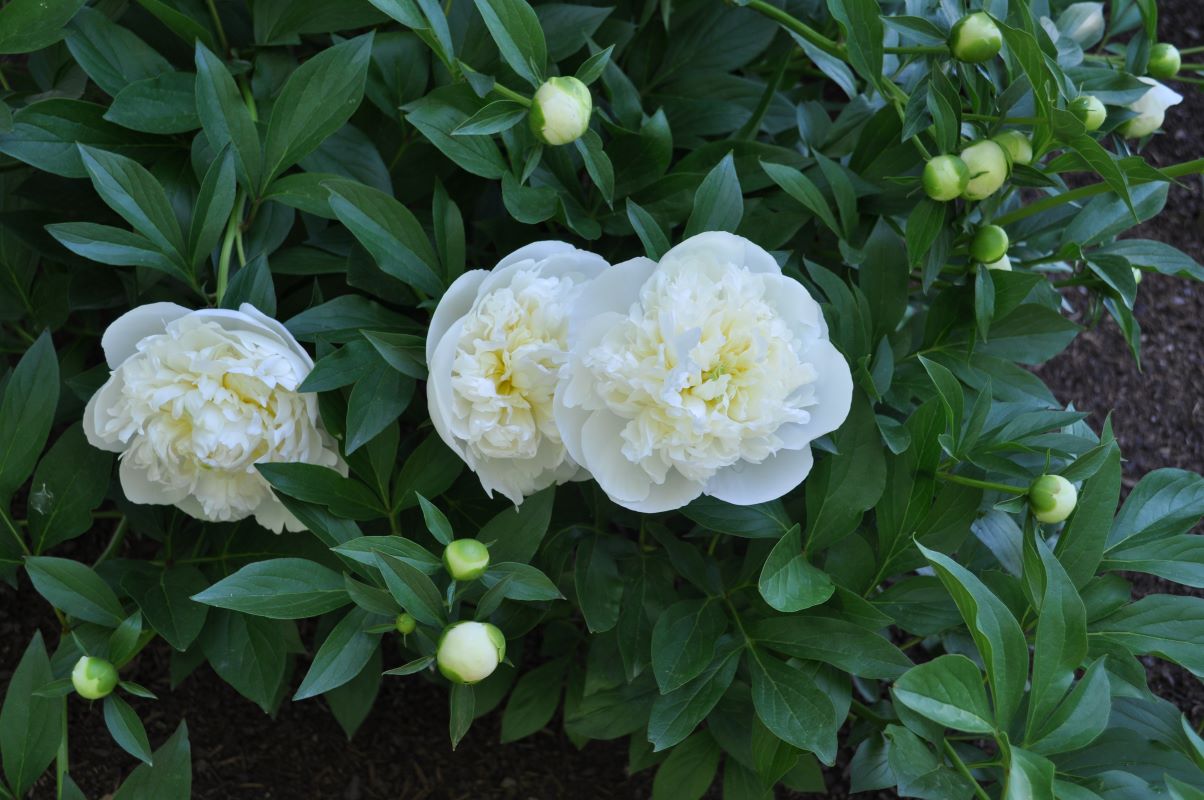
Duchesse de Nemours Peony Paeonia lactiflora 'Duchesse de Nemours'
This large, bushy perennial blooms in mid-spring, showing off large double-white, fragrant flowers. Its glossy green foliage is composed of lance-shaped leaflets and provides and attractive presence through the summer. They are adaptable to many different soil types and grow well with moderate amounts of water.
-
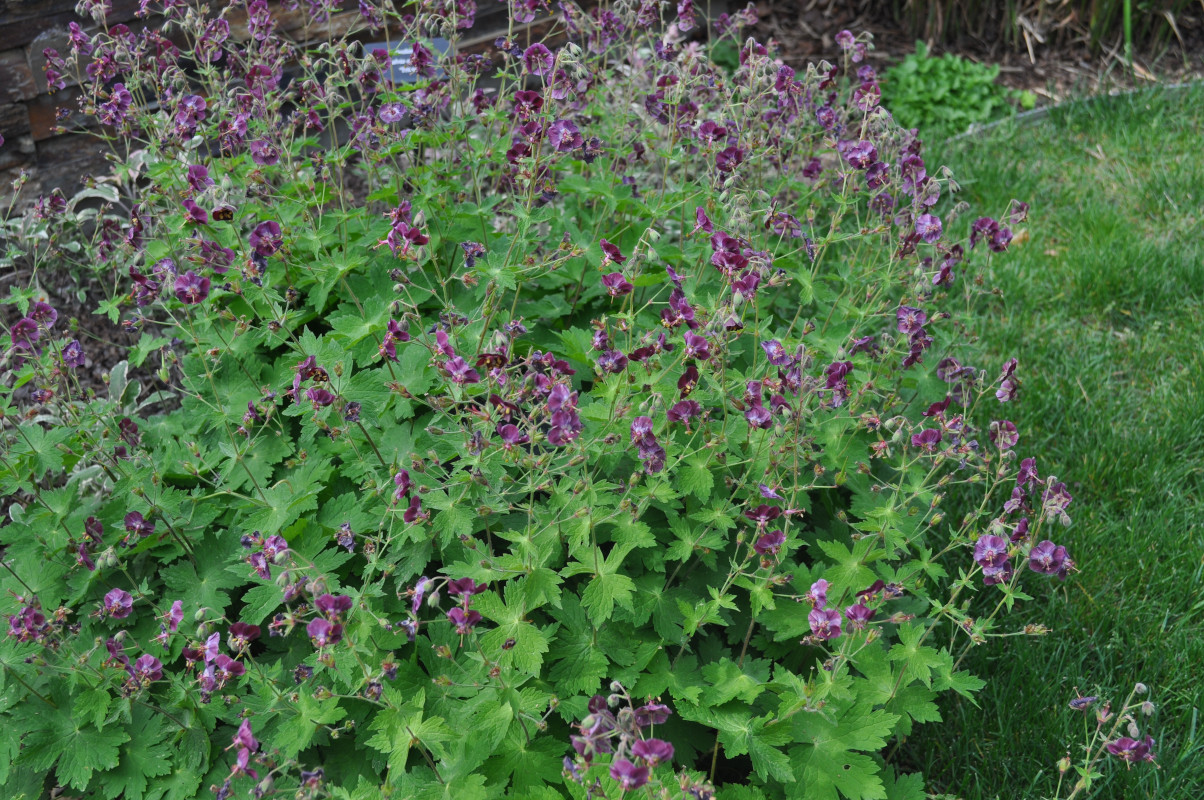
Dusky Cranesbill Geranium phaeum
Tall, clump-forming herbaceous perennial that performs best in part to full-shade and rich soils. Five-petaled, rich purple flowers bloom profusely in the spring and continue more sporadically into the summer. Dark-green leaves are deeply lobed and veined with maroon colorings at its base.
-

Dwarf Blue Rabbitbrush Ericameria nauseosa var. nauseosa
This is a compact strain of the native rabbitbrush. It grows in compact mounds of grayish-blue foliage. Golden-yellow blooms brighten the plant in late-summer to fall. It tolerates heavy soils and can survive on natural precipitation once established.
-
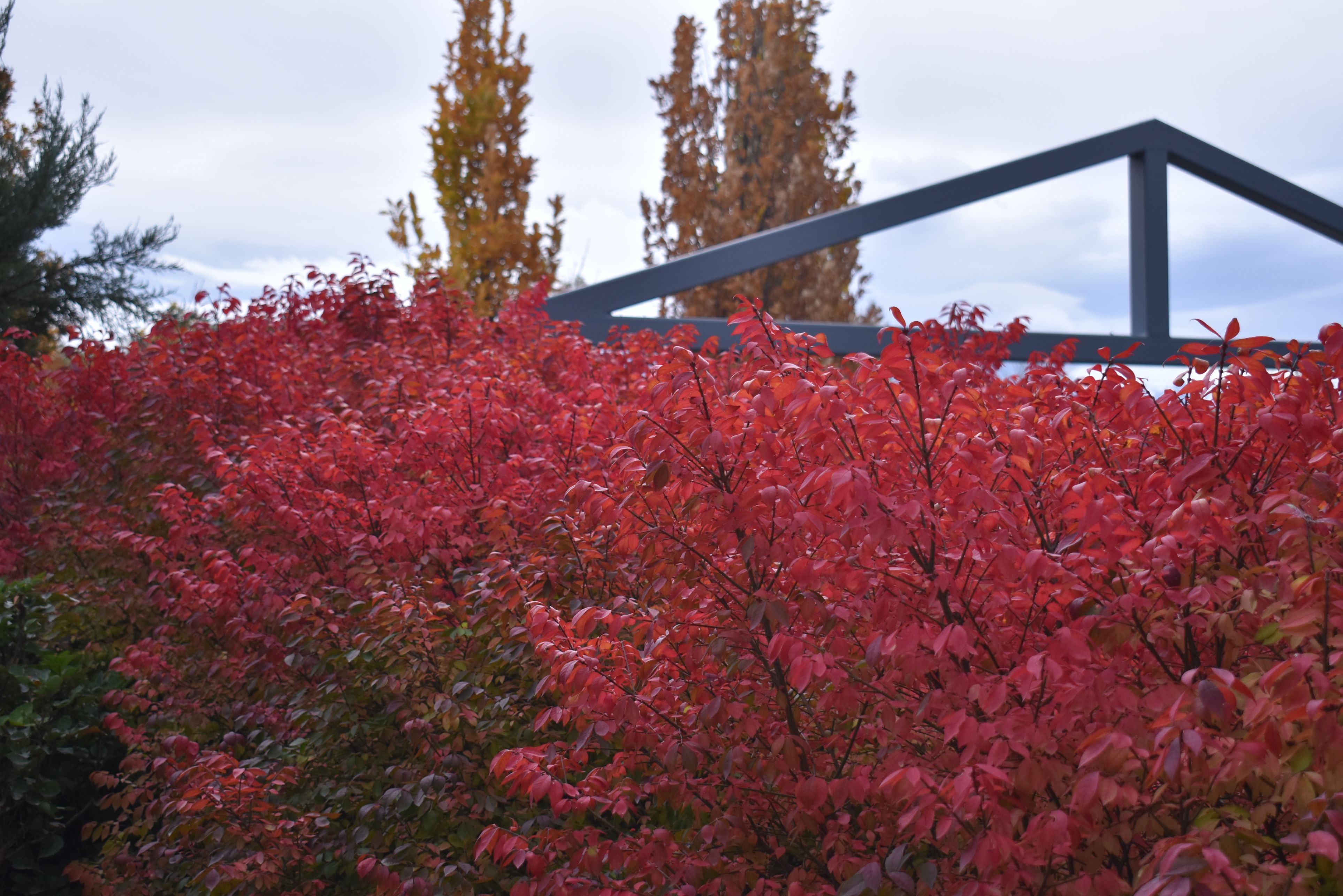
Dwarf Burning Bush Euonymus alatus 'Compactus'
A large, dense, bushy, deciduous shrub with dark green leaves that turn a brilliant red in autumn. Has a fairly slow growth rate and bears a insignificant white flower in May, followed by a small orange-red fruit, ripening in September. "Dwarf" is a bit of a misnomer, as this shrub can get up to 20 feet tall. Known to be invasive in wetter climates; may re-seed. Prefers full sun, but will tolerate some shade and moist well drained soils.
-
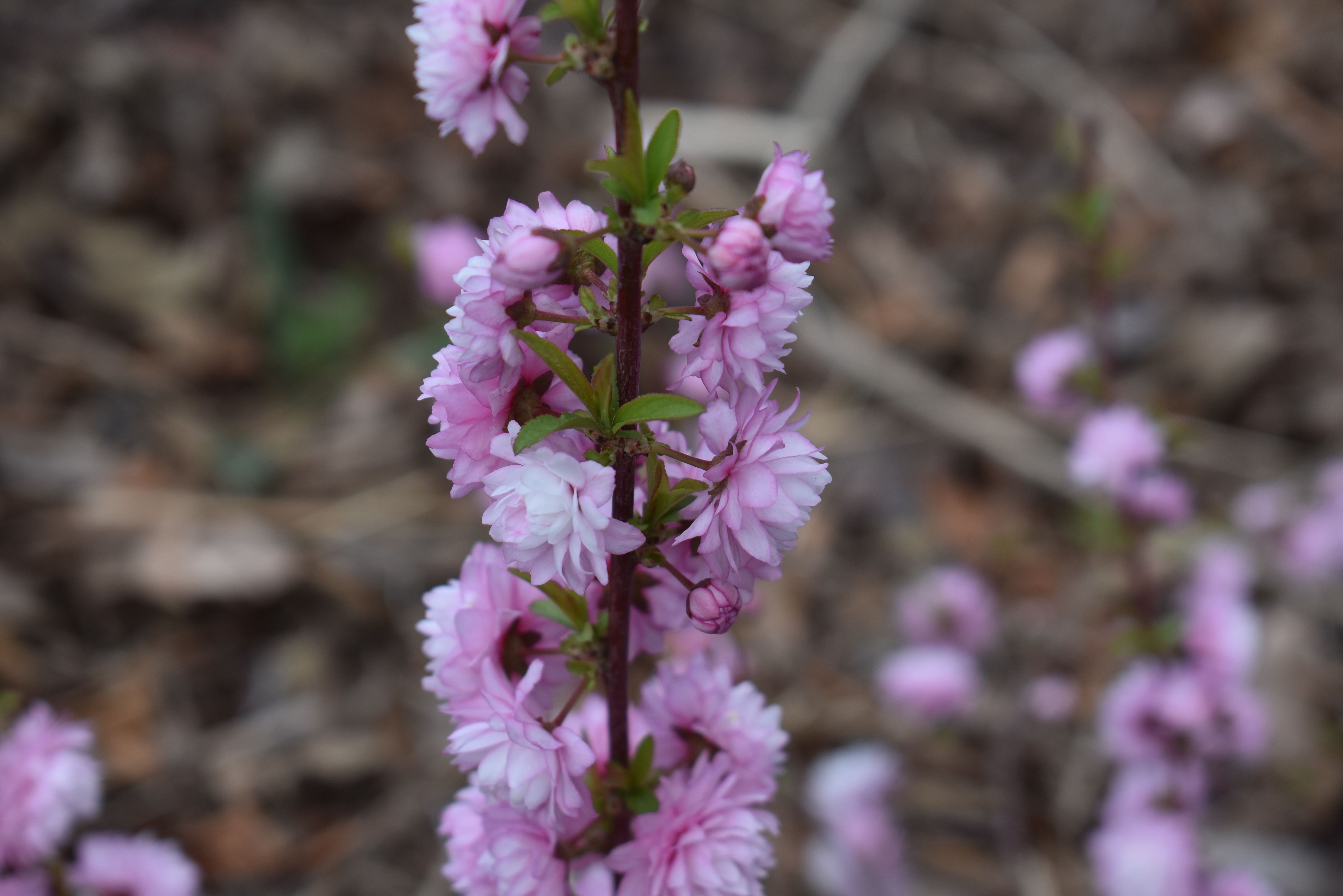
Dwarf Flowering Almond Prunus glandulosa 'Sinensis'
Multi-stemmed deciduous shrub with rounded form. This variety produces numerous double light-pink flowers in spring. Elliptic leaves are finely-toothed along the margins. Rarely produces dark-red spherical fruit which may be toxic. May be short-lived in the landscape.
-

Dwarf Golden Spur Columbine Aquilegia chrysantha var. chaplinei 'Little Treasure'
This exclusive release from High Country Gardens is a dwarf perennial that produces abundant golden-yellow, upward facing flowers with one-and-a-half inch long spurs in the late-spring to summer. The foliage forms a uniform mound of attractive rounded foliage. It prefers enriched soils and moderate water. It prefers shade, but will tolerate some sun.
-
Dwarf Korean Lilac Syringa meyeri 'Palibin'
Compact deciduous shrub with clusters of fragrant dusty pink to purple blossoms in early to mid-spring. Dark-green leaves are ovate and smaller than the species and has no fall color. Tolerant of alkaline soils and drought.
-
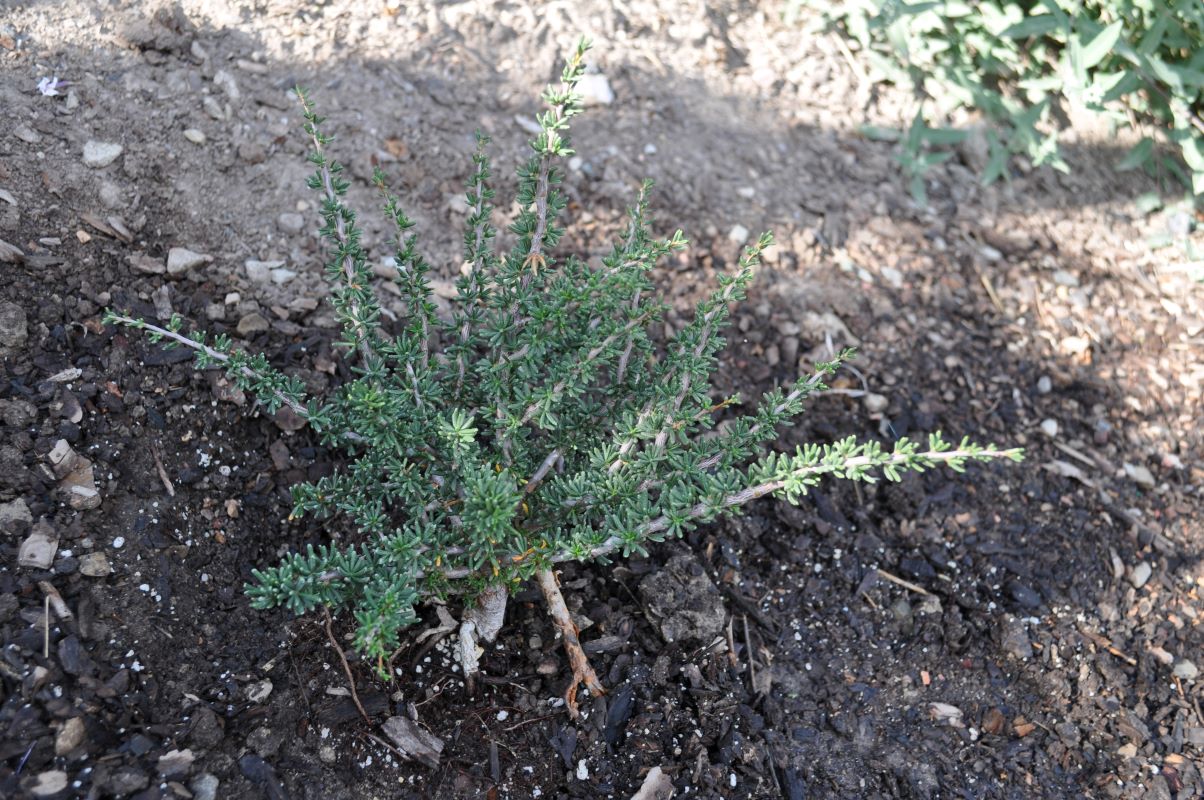
Dwarf Littleleaf Mountain Mahogany Cercocarpus ledifolius var. intricatus 'DoubleDown'
A dwarf selection of Little Leaf Mountain Mahogany. This native shrub has small, narrow evergreen leaves. It is drought tolerant and prefers well drained soils. It can work well as a bonsai style container-grown plant.
-
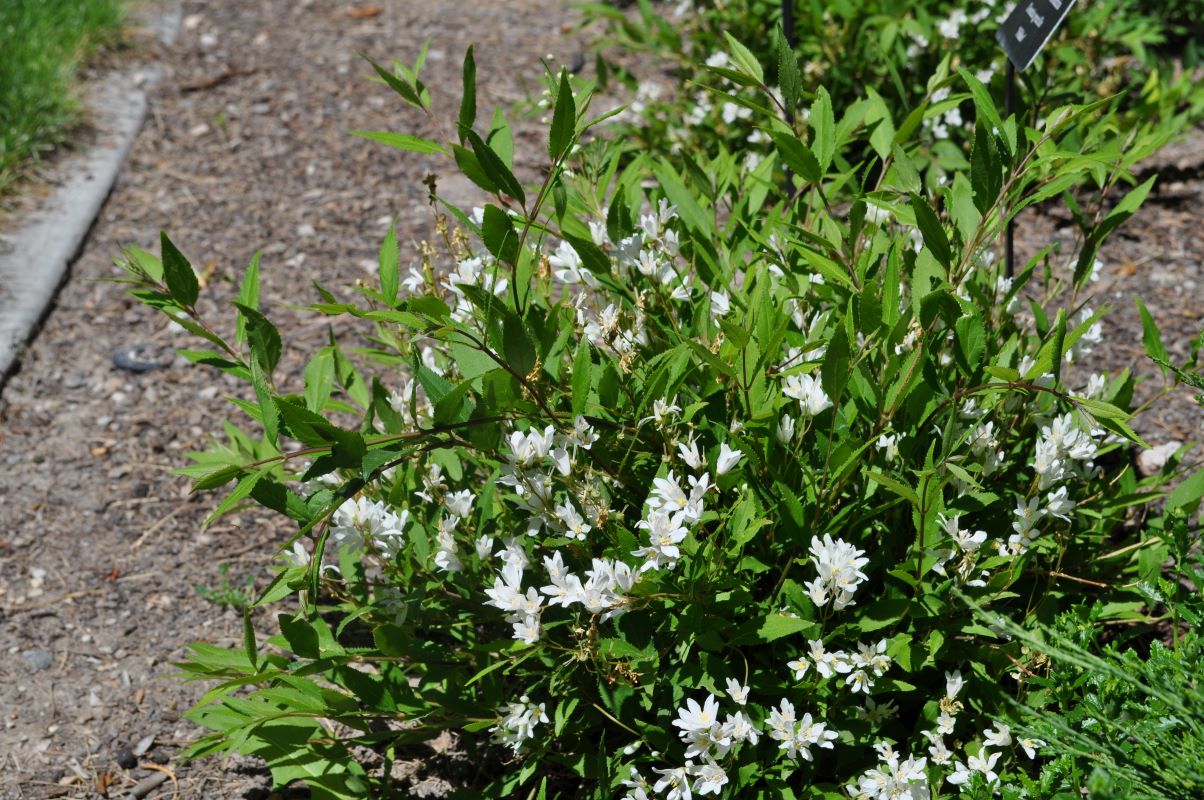
Dwarf Nikko Deutzia Deutzia gracilis 'Nikko'
This Deutzia is low growing and has a dense, rounded habit with gently arching branches. The leaves are medium to deep green and are willow-like in shape. The leaves turn deep burgundy in the fall. The flowers are fragrant, bell-shaped, tiny, white flowers in clusters 3 inches long. This plant tolerates a wide range of soils, but does prefer good drainage.
-

Dwarf Ninebark Physocarpus opulifolius 'Nanus'
Dwarfed deciduous shrub with clusters of white to pink flowers that bloom in the spring. Known for its exfoliating bark that reveals shades of red underneath. Dark green leaves are shallowly lobed and turn yellow in the fall. Tolerates some drought and alkaline soils.
-

Dwarf Norway Spruce Picea abies 'Pumila'
A small and compact evergreen which forms a rounded, cushion shape. This shrub is adorned with an abundance of vibrant green needles. Its low growing habit and slow growth makes it a great shrub for foundation planting or rock gardens.
-
Dwarf Oregon Grape Mahonia aquifolium 'Compacta'
Compact broadleaved evergreen. Holly-like glossy dark green leaves turn red to bronze in the winter. Clusters of bright yellow flowers bloom in the spring followed by blue to black berries. The berries are edible but generally not eaten raw. Can be used to make jams and jellies or left for the birds. Tolerates drought best in the shade. Leaves may scorch if in full sun and dry soil.
-
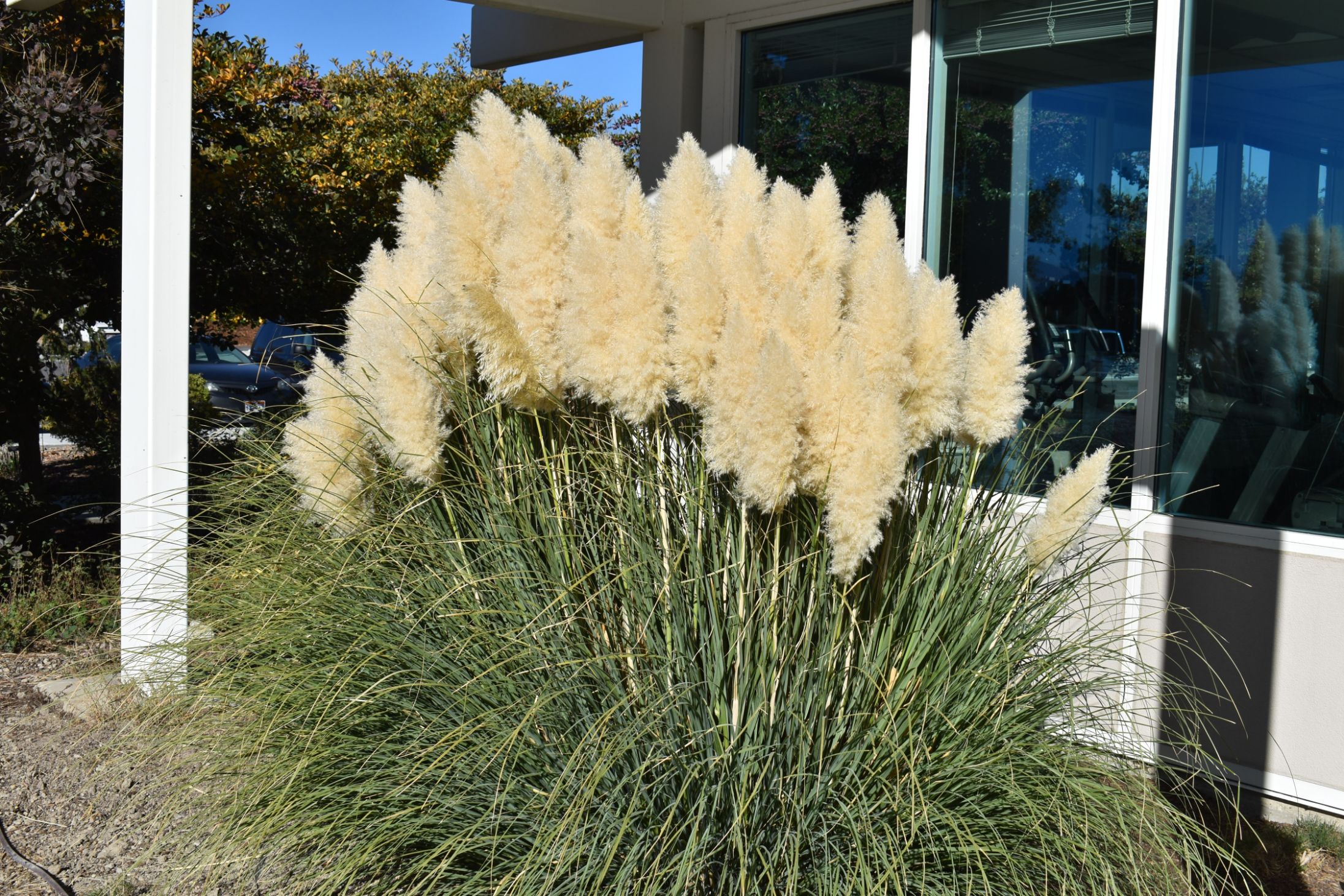
Dwarf Pampas Grass Cortaderia selloana 'Pumila'
Hardier dwarf version of pampas grass. Large white clusters of flowers are extremely showy. Grows best in warm locations and will need some shelter in northern Utah. Plant in full sun in well-drained soils. Seeds are sterile so it will not reseed.
-
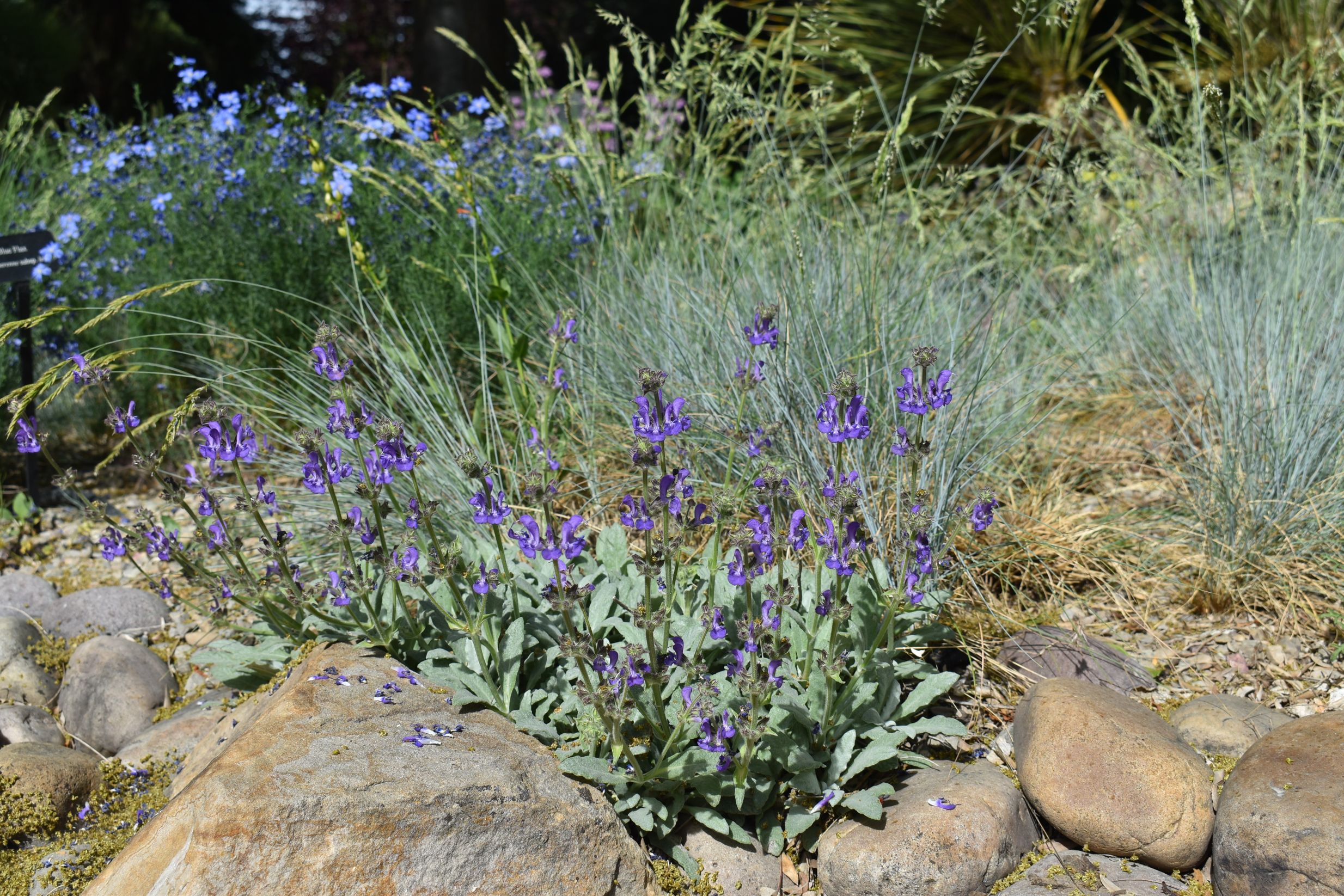
Dwarf Silver-Leaf Sage Salvia daghestanica
Clump-forming perennial and a 2004 Plant Select Winner, also known as Platinum Sage or Caucasus Sage. Spikes of stunning lavender-blue flowers bloom in late-spring above gray-green foliage that provides year round interest. Resistant to deer and rabbits. Prefers hot and dry locations in lean soil.
-
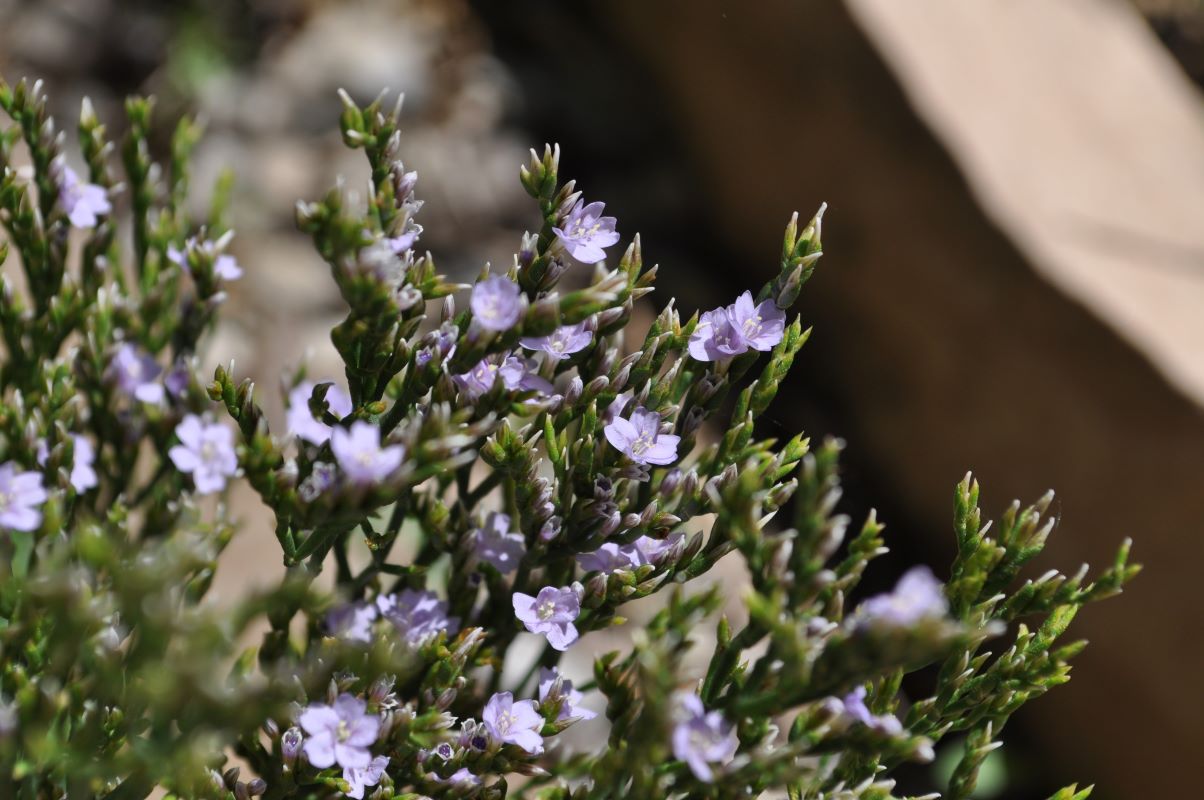
Dwarf Statice Limonium minutum
This showy perennial has tufted rosettes of tiny leaves. During mid-summer a dense thicket of finely branched stems produce tiny, lavender blooms. It grows well in narrow spaces such as rock gardens. It originates from the rocky coast of Southeastern France.
-
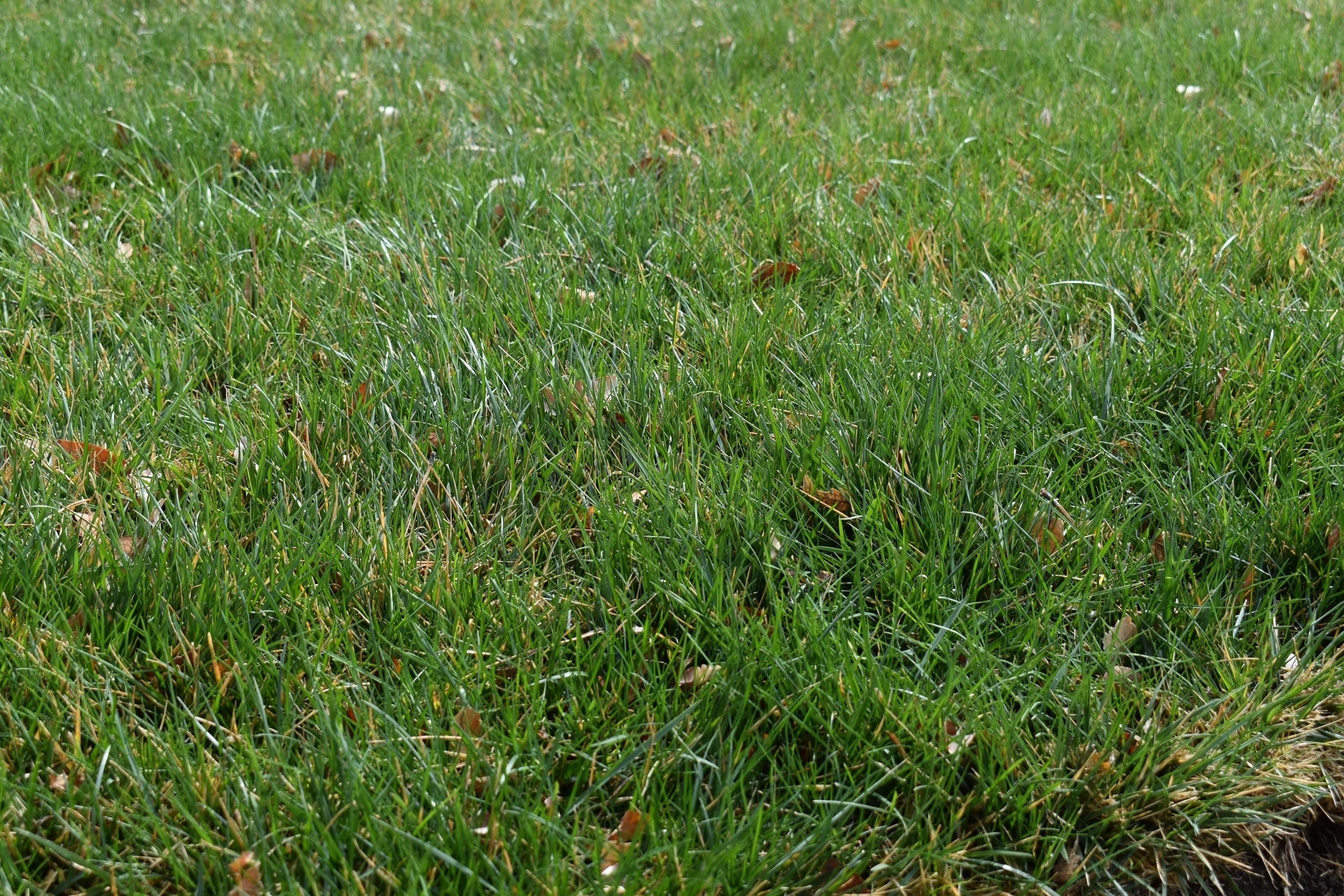
Dwarf Tall Fescue Festuca arundinacea
Deep rooted, dark green, cool season perennial turf grass. Tolerates some shade, foot traffic and recovers well after drought. Does best in well drained clay soils. Uses less water than Kentucky bluegrass with a similar look. Best kept cut at 3 inches or longer. This mix is no longer sold, but there are many good seed mixes available. This particular mix is composed of Ninja, Coyote, and Wyatt varieties. Improvements are constantly being made in the varieties available commercially. Consult your local sod or seed provider for information on the best varieties available.
-

Daffodil
Group of varied bulbous perennials. Flowers are borne singly or in small clusters and consist of a trumpet surrounded by petals. Long slender leaves are dark green. Sizes vary from under 6 inches to close to 30 inches. Very deer resistant and tolerant of a range of soil types. A good example of a drought avoider, blooming early and reaching dormancy before the hot and dry months.
Narcissus spp.
Mature Size: 6-30" tall x 6-12" wide
-
Dallas Blues Switch Grass
Clump-forming ornamental grass. Blue-green leaf blades are wider than most Panicums. Beautiful purple-tinged seed heads appear in late-summer to fall and provide great interest throughout the winter. Very versatile and tolerates a wide range of soil and climatic conditions. The species is native from Utah to the east coast.
Panicum virgatum 'Dallas Blues'
Mature Size: 4-6' tall x 2-3' wide
-

Dalmatian Bellflower
A low growing perennial that will add splashes of blue between steppingstones, along rock walls and climbing over rocks. The soft blue, bell-shaped flowers begin blooming in late spring and last through the summer. When it is out of bloom, rounded leaves with crinkled and irregularly toothed edges can be enjoyed.
Campanula portenschlagiana
Mature Size: 6-9" tall and 2-3' wide
-
Dalmatian Geranium
This tough perennial is native to the Balkan Mountains. Rounded, lobed leaves are covered by a flurry of pink flowers in the summer. Autumn brings orange and red hues to the leaves.
Geranium dalmaticum
Mature Size: 6" tall x 18" wide
-
Dancing Butterflies Peony
Clump-forming herbaceous flowering perennial. Large fragrant deep pink single flowers are borne in late-spring. This early blooming variety is a showstopper. Dark green deeply lobed leaves are also very attractive. Plant in fertile well-drained soils. Tolerates some drought once established.
Paeonia lactiflora 'Dancing Butterflies'
Mature Size: 28-30" tall and wide
-

Danford Reticulated Iris
A bright yellow-flowered reticulated iris blooming in late winter to early spring. Its fragrant primrose-yellow flowers are 2" in diameter with tiny brown and black spots. It has grass-like leaves that disappear by late spring.
Iris danfordiae
Mature Size: 4-6" tall and wide
-

Dark Green Spreader Yew
Dense, spreading evergreen shrub. This shrub can be used for a hedge, border, or screen. Dark green needle-like foliage reaches out from the plant. Scarlet ornamental berries pop out from the branches. This cultivar has a low growing habit.
Taxus x media 'Dark Green Spreader'
Mature Size: 3-4' tall x 4-6' wide
-

Dark Knight Bluebeard
This is a nice 2-3 ft tall and wide perennial/shrub. It is best treated as a perennial along the Wasatch by being cut back each year. Prefers drier soils and full sun. Produces small blue flowers clustered together along each long stem. This variety grows darker blue flowers with green foliage. Fast growing.
Caryopteris x clandonensis 'Dark Knight'
Mature Size: 3' tall and wide
-

Dark Towers Penstemon
A striking upright perennial with dark wine-purple foliage and stems, which are topped with loose spikes of light lavender-pink, tubular flowers that bloom in late spring or early summer. The contrasting color, sharply textured leaves, and upright stems bring height and drama to perennial borders, with excellent heat tolerance and little maintenance. Grows best in well-drained soils.
Penstemon 'Dark Towers'
Mature Size: 1-3' tall x 1-2' wide
-

Dark Vader Lungwort
This early spring bloomer has clusters of small, bell-shaped pink, blue and purple flowers. The low-growing, semi-evergreen dark green foliage is spotted with pale silver-green, providing texture and interest all season long. Makes a good spreading groundcover for shady areas; avoid planting in areas with afternoon sun.
Pulmonaria 'Dark Vader'
Mature Size: 10" tall x 20" wide
-

Dart's Gold Ninebark
Compact, mounded deciduous shrub. Lobed leaves emerge golden yellow and mature to lime green in the middle of the summer. Clusters of white to pink flowers bloom in spring. Bark is exfoliating and reveals shades of red to brown underneath. Tolerates alkaline soils and drought.
Physocarpus opulifolius 'Dart's Gold'
Mature Size: 4-5' tall and wide
-

Daub's Frosted Juniper
Striking golden foliage tips give this low-growing evergreen shrub a frosted appearance against blue-green mature foliage. It works great as a groundcover and for mass plantings. It can survive without supplemental water once established, and does well in heat.
Juniperus chinensis 'Daub's Frosted'
Mature Size: 1.5' tall x 5' wide
-

Davidson's Penstemon
A low-growing evergreen perennial that forms mats of leathery rounded dark green leaves. Bears clusters of dark pink or purple tubular flowers in late-spring to early-summer. Not as cold or heat tolerant as other penstemons but survives well in sheltered sites. Needs well-drained soils.
Penstemon davidsonii
Mature Size: 8" tall x 16" wide
-

Dazzler Sun Rose
Low-growing, evergreen shrubby perennial. Small, silvery green, lance-shaped leaves are downy. Bears profuse deep red rose-shaped flowers in late-spring to early-summer. Grows well as a groundcover or in rock gardens. Presents a very stunning show when covered with flowers.
Helianthemum 'Dazzler'
Mature Size: 12" tall x 24" wide
-

Deep Blue Arizona Sage
A selection of Arizona sage, this perennial is one of the few that will provide color in shady areas. Clusters of deep blue flowers bloom on stalks over deer resistant foliage.
Salvia arizonica 'Deep Blue'
Mature Size: 8-12" tall x 12-16" wide
-
Denim 'n Lace Russian Sage
Soft blue-purple flowers bloom atop gray green, subtly aromatic foliage. The blossoms are light and airy, creating an overall lacey effect. This perennial is great for adding color and fragrance to hot, dry areas in the landscape.
Salvia yangii (syn Perovskia atriplicifolia) 'Denim 'n Lace'
Mature Size: 2-2.5' tall x 2.5-3' wide
-

Desert Four O'Clock
This large Utah native plant spreads horizontally from a single large tap root. It has lush green leaves all season, with attractive magenta blooms appearing from mid-summer through frost. Requiring little or no additional water and not performing well if overwatered, this plant is a "must have" for any low-water landscape. Stems detach easily from the root at the end of the growing season for easy fall cleanup.
Mirabilis multiflora
Mature Size: 1-2' tall x 5-8' wide
-

Desert Penstemon
Semi evergreen perennial native to New Mexico. Bright pink to red tubular flowers bloom in summer. Large, gray-green leaves contrast nicely with the flowers. Prefers hot locations with dry, well-drained soils.
Penstemon pseudospectabilis
Mature Size: 36" tall x 18" wide
-

Desert Purple Sage
Fast-growing, heavy blooming, shrub. Native to the western United States. Highly aromatic gray leaves are resistant to browsing mammals. Brilliant pale-blue to purple flowers bloom in spring. Grows naturally in hot, dry, well-drained locations. Take care to not overwater in the landscape. Excellent plant choice for park strips.
Salvia dorrii
Mature Size: 30-36" tall x 36" wide
-

Desert Sunrise Hummingbird Mint
Upright growing fragrant perennial with a wispy look. Long-lasting bright orange-red blooms begin in mid-summer and last until the first freeze. This variety shows darker coloring than the species. Pale-green foliage emits a distinct root beer or licorice fragrance depending on your nose. Attractive to hummingbirds. Very drought tolerant but will use the water if it is available.
Agastache 'Desert Sunrise'
Mature Size: 3-4' tall x 2-3' wide
-

Desert Willow
Small, multi-stemmed, deciduous tree with bright pink orchid-like flowers appearing throughout the summer. It is a favorite of hummingbirds. Despite its name it is not actually a willow, but rather a member of the legume family. Native to Utah but only semi-hardy in our zone and may have some branch die-back during the coldest years. Sometimes behaves more like a large shrub.
Chilopsis linearis
Mature Size: 6-25' tall and wide
-

Desert Zinnia
Small, low-growing perennial native to the southwestern United States in some of the most inhospitable locations. Abundant, long-blooming golden-yellow flowers make this an attractive plant for any water-wise landscape. Comes out of dormancy in summer, so be patient. Prefers full sun and well-drained soil.
Zinnia grandiflora
Mature Size: 4" tall x 15" wide
-

Diabolo Ninebark
Upright, spreading, coarsely leaved shrub. The purple leaves of this cultivar provide a stunning backdrop for the bright whitish-pink flowers that appear in mid to late-spring. Bark exfoliates on older shrubs. In the heat of the summer, the leaves may green up slightly. Tolerates a wide range of soil conditions.
Physocarpus opulifolius 'Diabolo'
Mature Size: 4-8' tall and wide
-

Diana Rose of Sharon
Vigorous, multi-stemmed, upright, deciduous flowering shrub. Numerous showy, pure-white, single-flowers, are borne throughout the summer. Attractive 3-lobed, coarsely toothed leaves grow on erect stems. Tolerant of heat, drought, and poor soils. Prefers fertile soils with moderate amounts of water.
Hibiscus syriacus 'Diana'
Mature Size: 8-10' tall x 6-8' wide
-

Disco Belle Rosy Red Hardy Hibiscus
A vigorous, compact, shrubby herbaceous perennial. Dinner plate-sized, five-petaled rose red flowers bloom throughout the summer. It is part of the Disco Belle series which has other cultivars that bloom pink and red, this one is considered red. Needs consistent water and prefers rich organic soils. Very showy, should be planted where the flowers are readily visible.
Hibiscus moscheutos 'Disco Belle Rosy Red'
Mature Size: 24-30" tall x 18-24" wide
-

Disco Belle White Hardy Hibiscus
A vigorous, compact, shrubby herbaceous perennial. Showy, dinner plate sized flowers are five-petaled and white tinged pink with maroon eyes. The flowers bloom in late spring and early summer. Part of the Disco Belle series which has other cultivars that bloom pink and red, this one is considered white. Needs consistent water and prefers rich organic soils. Very showy, should be planted where the flowers are readily visible.
Hibiscus moscheutos 'Disco Belle White'
Mature Size: 3-4' tall x 2-3' wide
-

Doctor Alexander Fleming Peony
A clump-forming, bushy herbaceous perennial. Large pink fragrant blossoms are fully double. Outer petals are broad and spreading with curving inner petals. Deeply-lobed green foliage looks great even when not in bloom. Excellent as a cut flower. Plant in fertile soil. Do not overwater. Tolerates some drought once established.
Paeonia lactiflora 'Doctor Alexander Fleming'
Mature Size: 24-36" tall x 18-30" wide
-

Dog Tuff Grass
Dog Tuff is a deep-rooted, dense, low-growing turf grass. It is very drought resistant and provides a tough, durable lawn. Ideal for play, this grass stands up to dog traffic and dog urine with little or no damage. As a warm season grass, greening up won't happen until June and dormancy occurs in early October. Dog Tuff does not require mowing, but instead will gently mound. No seed is produced, but it does grow aggressively by underground rhizomes.
Cynodon hybrida Dog Tuff
Mature Size: 2.5" to 4" tall
-

Dolce Cherry Truffles Coral Bells
This low, mounding coral bells features ruffled, vivid red foliage. The leaves mature to a more rich, deep red. Summertime brings dainty, light pink flowers that pair beautifully with the bold foliage below. 'Cherry Truffles’ thrives in full sun to full shade, making it a great choice for any place in the landscape.
Heuchera 'Cherry Truffles'
Mature Size: 8-12" tall x 26-30" wide
-

Dolgo Crabapple
This large, rounded crabapple tree is known for its heavy crop of uniquely large, flavorful fruit which ripen in August and persist on the tree into December. The high-pectin fruit are prized for jelly making. In the spring it holds its own with plenty of long-blooming white flowers. Coppery-orange bark gives it visual interest year-round. Cold-tolerant, disease-resistant and great for pollinators and wildlife.
Malus 'Dolgo'
Mature Size: 18-25' tall x 12-15' wide
-

Dorset Sentry Red-Hot Poker
This perennial has fleshy grass-like leaves that grow in a clump. Tubular, acid yellow flowers grow in clusters on top of long stems. The leaves are mid-green and not too showy, but are easy to maintain when not flowering. Red hot pokers are robust plants that require some water but will handle drought.
Kniphofia 'Dorset Sentry'
Mature Size: 18-24" tall x 12-18" wide
-

Double Play Artisan Spirea
Compact, mounded plant known for its bright color of foliage and flower. New growth of leaves remain red and compliment with rich pink flower in summer. Easy to grow and has more vivid color than other species of Spirea.
Spiraea japonica 'Galen'
Mature Size: 2-3' tall and wide
-

Double Play Blue Kazoo Spirea
Part of the Double Play series, Blue Kazoo is noteworthy for its blue-green spring foliage that turns red in the fall. Clusters of white flowers bloom in late spring to early summer. The shrub is medium height and works best in full sun.
Spirea media 'SMSMBK'
Mature Size: 2-3' tall and wide
-
Double Play Gold Spirea
Compact, mounded deciduous shrub. Elliptical leaves emerge golden yellow turning to light green in the summer. Flat-topped clusters of dark-pink flowers bloom in late-spring to early summer. Grows best with moderate amounts of water and in full sun.
Spiraea japonica 'Yan'
Mature Size: 16-24" tall and wide
-

Double Scoop Cranberry Coneflower
The large cranberry-colored blossoms will bloom for months. Blooms will produce best when wilted flowers are removed. This coneflower is perfect for sunny borders or mixed containers.
Echinacea x purpurea 'Balscanery'
Mature Size: 24-26" tall and 16-22" wide
-
Double Take Peach Quince
This Flowering Quince outdoes many of the older varieties with its thornless nature and large, romantic peachy colored double blossoms. The flowers come on in spring and will add color and texture to the landscape for a long period of time. On top of this longer bloom period, the blooms often return in the fall and bring warm, spring color to the cooler part of the year.
Chaenomeles speciosa 'NCCS4'
Mature Size: 4-5' tall and wide
-

Double-Flowering Japanese Kerria
Graceful deciduous shrub with more upright growth than the species. Flowers appear in early-spring, many times around Easter, so it is sometimes called an Easter Rose. Bright-yellow flowers are double on this variety. Arching stems are slender and have a nice green color that remains throughout the fall. Flowers look the best in part-shade and will fade in full-sun.
Kerria japonica 'Pleniflora'
Mature Size: 5-10' tall and wide
-

Doublefile Viburnum
A wide-spreading deciduous shrub with tiered horizontal branches that are thickly topped with flat, lacy clusters of white flowers in spring, and showy red berries in fall. Foliage is dark green and deeply veined, giving it a pleated appearance. A stately and graceful shrub for mixed borders.
Viburnum plicatum f. tomentosum 'Shasta'
Mature Size: 6-8' tall x 9-12' wide
-
Doyenne du Comice Pear
Deciduous, fruit-bearing tree. Pure white flowers bloom in mid-spring followed by medium to large pears that ripen in October. Ripens to a greenish-yellow with a slight blush. Requires moderate amounts of water to support fruit growth. Like most fruit trees, it is available in different sizes depending on the grafted root system. Will require some pest control.
Pyrus communis 'Doyenné du Comice'
Mature Size: 8-10' tall and wide
-

Dragon's Blood Stonecrop
Vigorous, mat-forming, evergreen perennial with dark purple-tinted leaves. Late summer brings rounded corymbs of dark-pink flowers. Plant in well-drained soils. Prefers moderate amounts of water but may tolerate some drought. Flowers best in full sun.
Sedum spurium 'Schorbuser Blut'
Mature Size: 4" tall x 24" wide
-

Dream Catcher Beautybush
The leaves of this large shrub emerge with orange tones but quickly turn to yellow and then chartreuse as the season progresses with a finale of autumn gold and orange. It blooms in spring with pink, bell-shaped flowers. Mature bark exfoliates with maturity, which can be very attractive in winter. The stems can become dense and overgrown, so it needs plenty of pruning. Generally thinning will be enough, but an occasional cutting back will do some good. Flowers bloom on old wood, so cutting back the stems will result in no flowering for that season.
Kolkwitzia amabilis 'Maradco'
Mature Size: 6-9' tall and wide
-

Dropmore Scarlet Honeysuckle
Vigorously-growing semi-evergreen climbing vine. Leaves are rounded and often grow around the stem. Tubular red flowers are not very fragrant but attractive to hummingbirds. Twine stems around supports to help the plant grow upwards. Can handle severe pruning if overly vigorous.
Lonicera x brownii 'Dropmore Scarlet'
Mature Size: 10-12' tall x 10' wide
-
Druett's Variegated Campion
This perennial covers the ground with tiny, lance-shaped green variegated leaves. Small ballooned flowers bloom white in the summer. Great for rock gardens, rock walls and anywhere it can cascade or trail. It prefers good drainage and plenty of nutrients and moisture. However, it can handle some drought once established. Remove any solid-green shoots to maintain variegation, as this plant has a tendency to revert.
Silene uniflora 'Druett's Variegated'
Mature Size: 2-4" tall x 8-12" wide
-

Drumstick Onion
Ornamental bulbous perennial onion. Long linear basal leaves form untidy clumps. Forms tightly packed umbels of up to 40 pink to purple bell-shaped flowers in the summer. Plant in clumps 3 inches apart. Low water use and low maintenance. Good choice for full sun borders.
Allium sphaerocephalon
Mature Size: 20-36" tall x 12" wide
-

Duchesse de Lorraine Itoh Peony
This bushy perennial offers large, fluffy, creamy yellow blossoms in late spring to early summer. These flowers stand out against the dark green, lance-shaped leaflets. The Duchesse is perfect for adding bursts of color and fragrance throughout the landscape. The sturdy stalks make staking unnecessary.
Paeonia 'Duchesse de Lorraine'
Mature Size: 2-3' tall and wide
-

Duchesse de Nemours Peony
This large, bushy perennial blooms in mid-spring, showing off large double-white, fragrant flowers. Its glossy green foliage is composed of lance-shaped leaflets and provides and attractive presence through the summer. They are adaptable to many different soil types and grow well with moderate amounts of water.
Paeonia lactiflora 'Duchesse de Nemours'
Mature Size: 2-3' tall and wide
-

Dusky Cranesbill
Tall, clump-forming herbaceous perennial that performs best in part to full-shade and rich soils. Five-petaled, rich purple flowers bloom profusely in the spring and continue more sporadically into the summer. Dark-green leaves are deeply lobed and veined with maroon colorings at its base.
Geranium phaeum
Mature Size: 18-30" tall x 12-18" wide
-

Dwarf Blue Rabbitbrush
This is a compact strain of the native rabbitbrush. It grows in compact mounds of grayish-blue foliage. Golden-yellow blooms brighten the plant in late-summer to fall. It tolerates heavy soils and can survive on natural precipitation once established.
Ericameria nauseosa var. nauseosa
Mature Size: 20-30" tall and wide
-

Dwarf Burning Bush
A large, dense, bushy, deciduous shrub with dark green leaves that turn a brilliant red in autumn. Has a fairly slow growth rate and bears a insignificant white flower in May, followed by a small orange-red fruit, ripening in September. "Dwarf" is a bit of a misnomer, as this shrub can get up to 20 feet tall. Known to be invasive in wetter climates; may re-seed. Prefers full sun, but will tolerate some shade and moist well drained soils.
Euonymus alatus 'Compactus'
Mature Size: 15-20' tall x 10' wide
-

Dwarf Flowering Almond
Multi-stemmed deciduous shrub with rounded form. This variety produces numerous double light-pink flowers in spring. Elliptic leaves are finely-toothed along the margins. Rarely produces dark-red spherical fruit which may be toxic. May be short-lived in the landscape.
Prunus glandulosa 'Sinensis'
Mature Size: 5' tall and wide
-

Dwarf Golden Spur Columbine
This exclusive release from High Country Gardens is a dwarf perennial that produces abundant golden-yellow, upward facing flowers with one-and-a-half inch long spurs in the late-spring to summer. The foliage forms a uniform mound of attractive rounded foliage. It prefers enriched soils and moderate water. It prefers shade, but will tolerate some sun.
Aquilegia chrysantha var. chaplinei 'Little Treasure'
Mature Size: 15" tall x 10" wide
-
Dwarf Korean Lilac
Compact deciduous shrub with clusters of fragrant dusty pink to purple blossoms in early to mid-spring. Dark-green leaves are ovate and smaller than the species and has no fall color. Tolerant of alkaline soils and drought.
Syringa meyeri 'Palibin'
Mature Size: 4-5' tall x 5-7' wide
-

Dwarf Littleleaf Mountain Mahogany
A dwarf selection of Little Leaf Mountain Mahogany. This native shrub has small, narrow evergreen leaves. It is drought tolerant and prefers well drained soils. It can work well as a bonsai style container-grown plant.
Cercocarpus ledifolius var. intricatus 'DoubleDown'
Mature Size: 5-6' tall x 4-5' wide
-

Dwarf Nikko Deutzia
This Deutzia is low growing and has a dense, rounded habit with gently arching branches. The leaves are medium to deep green and are willow-like in shape. The leaves turn deep burgundy in the fall. The flowers are fragrant, bell-shaped, tiny, white flowers in clusters 3 inches long. This plant tolerates a wide range of soils, but does prefer good drainage.
Deutzia gracilis 'Nikko'
Mature Size: 1-2' tall x 2-5' wide
-

Dwarf Ninebark
Dwarfed deciduous shrub with clusters of white to pink flowers that bloom in the spring. Known for its exfoliating bark that reveals shades of red underneath. Dark green leaves are shallowly lobed and turn yellow in the fall. Tolerates some drought and alkaline soils.
Physocarpus opulifolius 'Nanus'
Mature Size: 1-2' tall x 2-3' wide
-

Dwarf Norway Spruce
A small and compact evergreen which forms a rounded, cushion shape. This shrub is adorned with an abundance of vibrant green needles. Its low growing habit and slow growth makes it a great shrub for foundation planting or rock gardens.
Picea abies 'Pumila'
Mature Size: 3-4' tall x 4-6' wide
-
Dwarf Oregon Grape
Compact broadleaved evergreen. Holly-like glossy dark green leaves turn red to bronze in the winter. Clusters of bright yellow flowers bloom in the spring followed by blue to black berries. The berries are edible but generally not eaten raw. Can be used to make jams and jellies or left for the birds. Tolerates drought best in the shade. Leaves may scorch if in full sun and dry soil.
Mahonia aquifolium 'Compacta'
Mature Size: 2-3' tall x 4' wide
-

Dwarf Pampas Grass
Hardier dwarf version of pampas grass. Large white clusters of flowers are extremely showy. Grows best in warm locations and will need some shelter in northern Utah. Plant in full sun in well-drained soils. Seeds are sterile so it will not reseed.
Cortaderia selloana 'Pumila'
Mature Size: 6' tall x 3' wide
-

Dwarf Silver-Leaf Sage
Clump-forming perennial and a 2004 Plant Select Winner, also known as Platinum Sage or Caucasus Sage. Spikes of stunning lavender-blue flowers bloom in late-spring above gray-green foliage that provides year round interest. Resistant to deer and rabbits. Prefers hot and dry locations in lean soil.
Salvia daghestanica
Mature Size: 10-12" tall x 12" wide
-

Dwarf Statice
This showy perennial has tufted rosettes of tiny leaves. During mid-summer a dense thicket of finely branched stems produce tiny, lavender blooms. It grows well in narrow spaces such as rock gardens. It originates from the rocky coast of Southeastern France.
Limonium minutum
Mature Size: 6" tall and wide
-

Dwarf Tall Fescue
Deep rooted, dark green, cool season perennial turf grass. Tolerates some shade, foot traffic and recovers well after drought. Does best in well drained clay soils. Uses less water than Kentucky bluegrass with a similar look. Best kept cut at 3 inches or longer. This mix is no longer sold, but there are many good seed mixes available. This particular mix is composed of Ninja, Coyote, and Wyatt varieties. Improvements are constantly being made in the varieties available commercially. Consult your local sod or seed provider for information on the best varieties available.
Festuca arundinacea
Mature Size: 24-36" tall x 12-18" wide